22. THE LATER 1960s

JOHNSON ATTEMPTS TO BUILD A "GREAT SOCIETY"
CONTENTS
 The American presidency under The American presidency under
Johnson ... not quite Camelot!
 The making of Lyndon Baines Johnson The making of Lyndon Baines Johnson
(LBJ)
 The civil rights movement gains steam The civil rights movement gains steam
 Johnson's "Great Society" program – Johnson's "Great Society" program –
May 1964
 American politics takes a left turn under American politics takes a left turn under
Johnson
 The continuing attempt to protect The continuing attempt to protect
religion from Secular-Judicial regulation
 Race relations worsen Race relations worsen
 Affirmative action also for women and Affirmative action also for women and
Hispanics as suffering "minorities"
 The growth of the Federal state ... and The growth of the Federal state ... and
the Federal debt
The textual material on this webpage is drawn directly from my work
America – The Covenant Nation © 2021, Volume Two, pages 171-190.
THE AMERICAN PRESIDENCY UNDER JOHNSON ... NOT QUITE CAMELOT! |
|
The changing of the guard at the White House
Americans were stunned by the thought that they
had lost the very charming, very charismatic president who gave
American politics even within sophisticated Europe the reputation of a
quite high level of sophistication itself. But now Americans
awakened to the realization that with Vice President Johnson now as the
new U.S. President, that style was gone, very gone. Instead
Johnson gave off the appearance of being simply another Southern "good
old boy."
But appearances can be quite deceiving!
With the assassination of the young
President Kennedy in 1963, actually in Lyndon Baines Johnson
(LBJ) a quite sophisticated (in his own way) veteran of Capitol Hill
politics now assumed the Presidency. Lyndon Johnson's political goals
were similar to Kennedy's: a Liberal Democrat who emphasized the
importance of American civil rights and also one who understood that
Communism was still the greatest threat to America. However, his
political strategy and style in addressing these challenges to America
was drastically different.
The original expectation of "business as usual"
in the presidential changeover
At the time Johnson stepped into the
American Presidency, "government" meant the Americans themselves. The
state did not rule. The people ruled. A formal government consisting of
the people's representatives existed solely to service the people and
their general will, as the people themselves directed these
representatives (the power of the voting booth). The economy belonged
to the people as consumers and their private businesses that answered
their consumer demands. Educational policy belonged to the American
families and their local school boards. Health care belonged to
the people and their doctors.
National government was largely left only
to deal with international issues, as had been the intention of the
original Framers of the Constitution, and had largely been the pattern
since then.1
Of course, the Great Depression and then
World War Two had challenged deeply that view. During that time period
(the many years of FDR's presidency) the Washington political
Establishment had taken a very commanding position in American life.
But those periods were considered merely temporary, necessitated by the
extreme demands facing America in those days. It was also expected, and
indeed seemed to be the case, that when those emergencies were put
behind the country, it would then return to national business as usual.
Thus it was that going into the new
Johnson presidency, there was still little sense that the national
government in Washington had any important role to play in the nation's
domestic affairs. True, there was the huge domestic program, Social
Security, a pension fund for the elderly, managed by the national
government. But in this the Washington government was considered to be
only the caretaker of this huge pension fund, not the owner of
it. Social Security too belonged to the people.
In any case, there seemed to be little
reason under the new president for things to change in Washington,
other than simply a different personality now living in the White
House. There were no earth-shaking national crises that required a
dramatic shift in America's "business as usual." True there were issues
at hand, as always. Black civil rights was an issue needing national
attention. But Congressional politics, voicing the changing will of the
American people on this matter, was supposedly quite sufficient to
handle this matter. And as far as foreign policy was concerned, the
Cold War was still on, but not really much changed in character over
the recent years. And again, Washington's small but capable foreign
policy teams in the White House and Congress seemed more than able to
handle this challenge, as it had since the end of World War Two.
Thus it was that Americans, stunned by
the tragic loss of President Kennedy, nonetheless carried on, expecting
things to continue forward pretty much in a rather widely accepted
traditional manner.
But
actually, all this would all change – change drastically – during the
five years of Johnson's presidency. And this was because the new
president brought to Washington politics a very different understanding
of what "business as usual" was supposed to look like.
1The 10th Amendment – the famous "Reservation Clause" – concludes the Bill of Rights: The
powers not delegated to the United States by the Constitution, nor
prohibited by it to the States, are reserved to the States
respectively, or to the people. This meant that unless the
Constitution had specifically assigned powers to Congress to act in
certain matters, all other political activities were reserved to the
States and the people ... the federal counterbalance of the states in
"checking" the powers of the national government – against the tendency
of all ruling bodies to want to expand their powers at will. But such
checks on central (Washington, D.C.) power would be put aside during
the Johnson years.
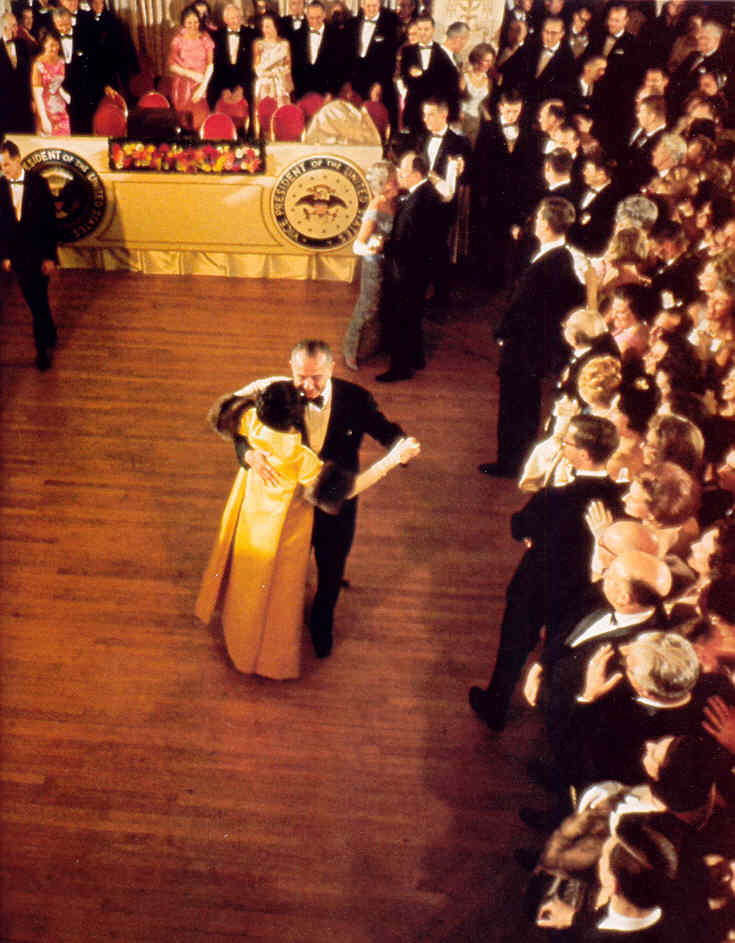
Nice ... but not quite
Camelot. Lyndon and Lady Bird Johnson
dancing at LBJ's inaugural ball – January 20, 1965 (Vice President Hubert Humphrey
and his wife in the background)
THE MAKING OF LYNDON BAINES JOHNSON (LBJ) |
|
Johnson grew up on a farm in the tiny and
rather remote community of Stonewall, Texas, in a condition of constant
poverty and humble social circumstances, although his family had a
somewhat impressive history dating back to the early days of Texas. In
fact, the nearest town in the region, Johnson City, was named after one
of his relatives. The young Lyndon attended high school in Johnson
City, and eventually entered Southwest Texas State Teachers College in
San Marcos, where he developed a taste for politics and ended up as
editor of the school newspaper. He took time off during his studies to
teach a full school-year to Hispanic-American children, which touched
deeply an old nerve in Johnson, one that never failed to make him
greatly concerned about the problems that people face living in utter
poverty – something he personally could identify with closely.
Graduating in 1930, he found a position
teaching high school public speaking in Houston and also got involved
in Richard Kleberg's Congressional campaign. With Kleberg's victory in
late 1931, Johnson followed him to Washington, D.C., where he found
himself by natural impulse organizing Congressional aides into
something of a political fellowship. Eventually that fellowship would
include staff members of newly elected President Roosevelt. But it
would also grow to include even a direct friendship with Vice President
John Nance Garner and powerful Speaker of the House Sam Rayburn, both
Texans. In fact, Johnson's relationship with Rayburn would grow over
the years, forming a strong political bond between the two.
In 1934 he married Claudia ("Lady Bird")
Taylor of Texas, whose mother (of aristocratic Alabama ancestry) died
when Ladybird was only five. Her father was a strong-willed Alabama
sharecropper who managed to move to Texas and put together a fortune,
coming to own 15,000 acres of cotton and two general stores. Growing
up, Lady Bird ventured back and forth between Texas and Alabama, but
eventually attended and graduated from the University of Texas, and
then headed on to Washington, D.C., where she met Johnson, marrying him
only ten weeks later.
In 1935 he returned to Texas to became
head of the Texas National Youth Administration, a big part of
Roosevelt's New Deal, given the task of setting up government-sponsored
jobs and job-training for unemployed Texas youth. This was a key
component of Johnson's understanding of the proper role of government,
one that would stay with him during the years ahead as he entered more
fully into political life.
In 1937, financed heavily by his wife, a very ambitious Johnson ran
successfully in a special Congressional election, and would continue to
serve in the U.S. House of Representatives during the next dozen years,
most importantly during World War Two, proving to be a key supporter of
Roosevelt's legislative agenda. He joined the U.S. Naval Reserve in
1940, was commissioned as a Lieutenant Commander, and when America
entered the war in December of 1941, he was called to active duty. He
wanted a combat appointment but instead was put to use by Roosevelt
during the early part of the war as an investigator into general
conditions of the U.S. Navy in the Pacific, this leading him eventually
to be a chairman of a key subcommittee of the House Naval Affairs
Committee investigating navy contracts with America's manufacturers
(similar to Truman's role in the Senate investigating army contracts
during the same period).
After the war, in the 1948 national
election, Johnson ran for a U.S. Senate seat, gaining (very narrowly,
and very questionably) the Democratic Party nomination, and thus in the
Dixiecrat South (which included Texas) most assuredly the subsequent
election itself (Southerners at that time were still refusing to vote
Republicans to any office). Now in the Senate, Johnson was quick to
befriend the powerful Senator Richard Russell and also help create and
then lead a Senate subcommittee investigating government contracts with
the defense industry, very similar to the role he played in the House
of Representatives.
By 1951 he had gained the key position of
Senate Democratic Party Majority Whip. Then when in the 1952 elections
(which brought Eisenhower to the White House) the Republicans swept the
Democrats out of power in both houses of Congress, in the new Senate
political reshuffle in early 1953 Johnson was elected by fellow
Democrats as the new minority party leader. This made him the youngest
person ever to be elected to that powerful position (he was only
forty-four at the time). Then when in the 1954 elections the Democratic
Party regained the majority in the Senate, Johnson became the majority
party leader. This would make him not only one of the youngest but also
one of the most powerful leaders in Washington, D.C.
Johnson grew up in a family that had a
number of Baptist pastors in its recent genealogy on his mother's side
of the family, whereas his father had merely a distant relationship
with the world of religion, only occasionally attending the Disciples of
Christ (DOC, or just "Christian") Church in Johnson City. But it was in
this church that Johnson would grow up, a rather different sort of
denomination than the Southern Baptists and Methodists of the
camp-revival variety that dominated the local religious scene. The DOC
had been founded in the 1800s in an effort to create a Christian form
that adhered to no particular doctrinal or liturgical structure. And
this seemingly left its mark on Johnson, who in later years (really
only after he became president in late 1963) would find himself
comfortable in any of America's Christian denominations, even Catholic.
And he especially loved to find himself in the company of pastors, of
any variety. But actually, Johnson seemed to develop a preference for
the more liturgical (Catholic and Episcopalian) churches to attend,
although ultimately he could be wide-ranging in his choice of where he
would worship on any particular Sunday, sometimes even attending more
than one church on that same morning. Part of this was that he truly
felt at home within the broader spectrum of Christianity. But he also
liked to be out in the crowds (always hating to be alone). Of course
this never hurt his political status either. Also it kept him one step
ahead of the press, who naturally wanted the week's latest story on
where Johnson had attended church (he loved to keep the press guessing).
But clearly the one person who meant the
most to the president in the religion category was the evangelist Billy
Graham (whose contact with President Kennedy had been quite minimal).
Graham and Johnson became very close over the years of the Johnson
presidency. Graham was called on to speak at every one of the
presidential prayer breakfasts in those years, and Graham met
frequently with the president both in the White House and on Johnson's
Texas farm, to pray and offer comfort to a personal friend who was well
aware of the troubles his presidency had come to encounter. Johnson
even asked him in 1964 as to who he thought would make the best running
mate, to which Graham wisely declined to give an answer! Graham stayed
with Johnson the president's last night at the White House, and
eventually would be called on to conduct Johnson's funeral service
(1973). But very little of this close relationship was known outside
the inner Johnson social-political circle.
Johnson never saw the need to personally
inspire, through his own spiritual qualities, a "Christian America." He
did not usually talk about his religion publicly, or bring religion
into his public arena. Although he himself personally was a fairly
strong Christian, and found himself in personal prayer often over his
work, his public working-world was strictly Secular, and would remain
that way, even through all the difficulties he would face in trying to
lead the nation.
Johnson carefully researched every person
he would have to work with in Washington, finding their strengths and
weaknesses, their positions on various issues. Indeed, he was
well-known for his ability to go to work on his political colleagues,
towering over them hugely (he was a big man) in personal face-to-face
discussions, literally so, only an inch or two separating his face from
theirs as he pressed his views upon his intimidated victims.
He was very sensitive to the blemish of
poverty still afflicting the supposedly prosperous nation. Very
importantly in how he viewed this issue, he had come into the world of
politics as a young man deeply committed to Roosevelt's New Deal
program, and had a strongly ingrained sense that the government in
Washington was the best source of solid political, economic and social
reform for the nation – despite whatever the Constitution had to say on
these matters.
Also, as a Southerner, personally stung
by the way fellow Southerners had dug in their heels against Black
civil rights, he was by no means convinced that a mere appeal to the
American conscience was sufficient to get Americans to do the right
thing. Thus to Johnson it seemed to make more sense to him, on a number
of different political fronts, that real reform had to come to America
by way of a strong central authority, namely the Washington government
that Johnson had come to know quite well.
Besides, he was well-aware of the fact
that he lacked the personal qualities that could charm the American
people to action like Kennedy. He did not have a charismatic
personality that could move the public like King. No, he was a
behind-the-scenes political maneuverer – a very effective one at that.
He could get things done in Washington that not even a Kennedy or a
King could achieve, because of the huge amount of personal political
leverage he had developed in dealing with the other members of Congress
as Senate minority and then majority leader.
Johnson was also one very impressed with
professional credentials, ones that distinguished the experts of
Washington's powerful political circles from the common folk back home.
He was very definitely a deeply committed "Washington insider," as few
U.S. presidents before him had been.
Thus he would eventually come to put
forward his Great Society idea, a set of government programs run out of
Washington by political professionals, which he felt was the most
effective way to bring America to perfection. To Johnson's way of
thinking, professional economists, public administrators, lawyers,
etc., brought to Washington to engage in their professional work and
duties, seemed by far to be the best way to get the job done of
perfecting America.
So it was that Johnson pursued American
politics not along the lines of great idealistic challenges to equally
idealistic (and socially self-motivated) Americans, as Kennedy had, but
more in terms of an aggressive out of sight herding forward of the
Washington congressional and executive bureaucratic machinery. He
relentlessly pushed forward his political program of social reforms
through this Washington political machine – expanding it to rather
colossal proportions in the process.
Under Johnson, Washington D.C. transformed itself into a great imperial
metropolis – also improved greatly in appearance through his wife Lady
Bird's huge efforts to make the capital appear indeed to be just such
an imperial metropolis.
|
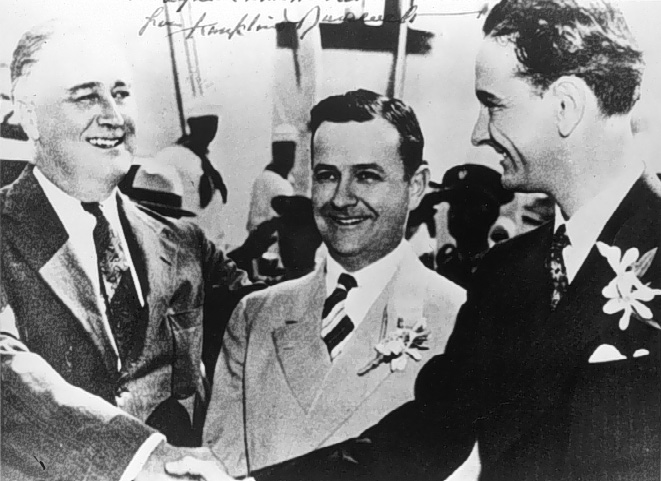
1937 – President Roosevelt, shaking hands with LBJ ...
with Texas Governor James Allred between the two men
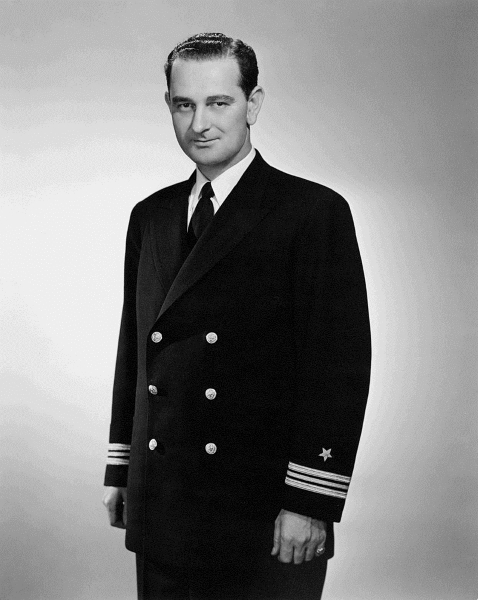
1942 – LBJ in his naval uniform
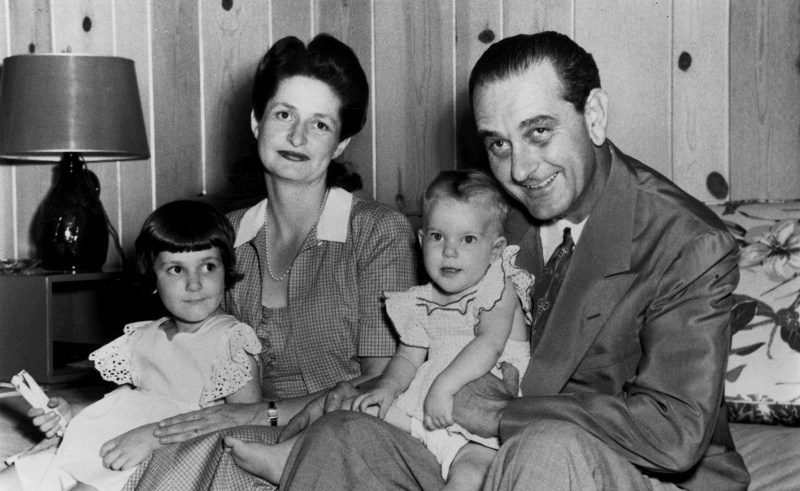
Johnson with Lady Bird and their two daughters – 1948
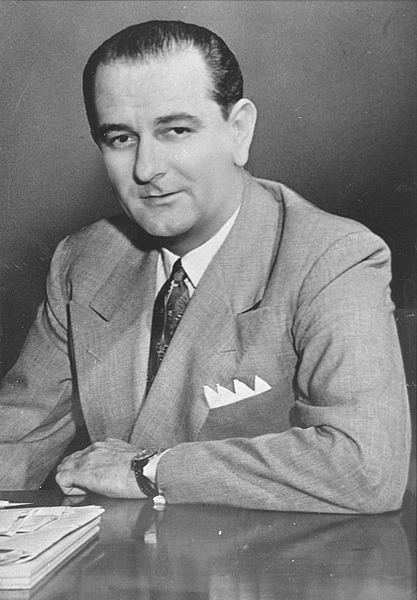
Johnson as U.S. Senator from Texas
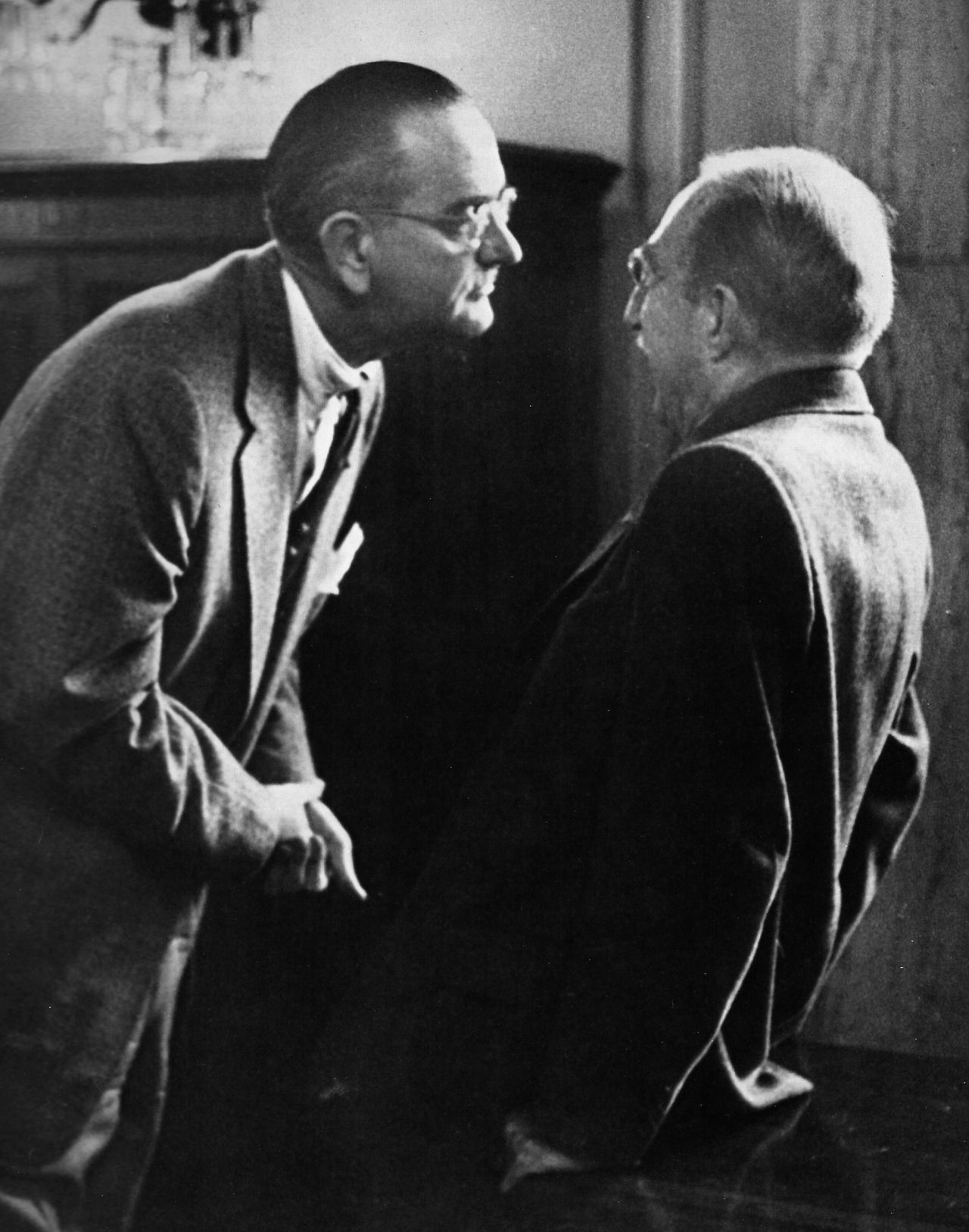
Senator Green getting the "Johnson Treatment" – 1957
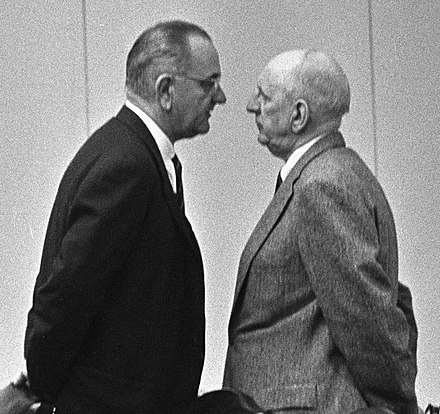
Sen. Russell having a heart-to-heart (or nose-to-nose) talk with Johnson! – 1963
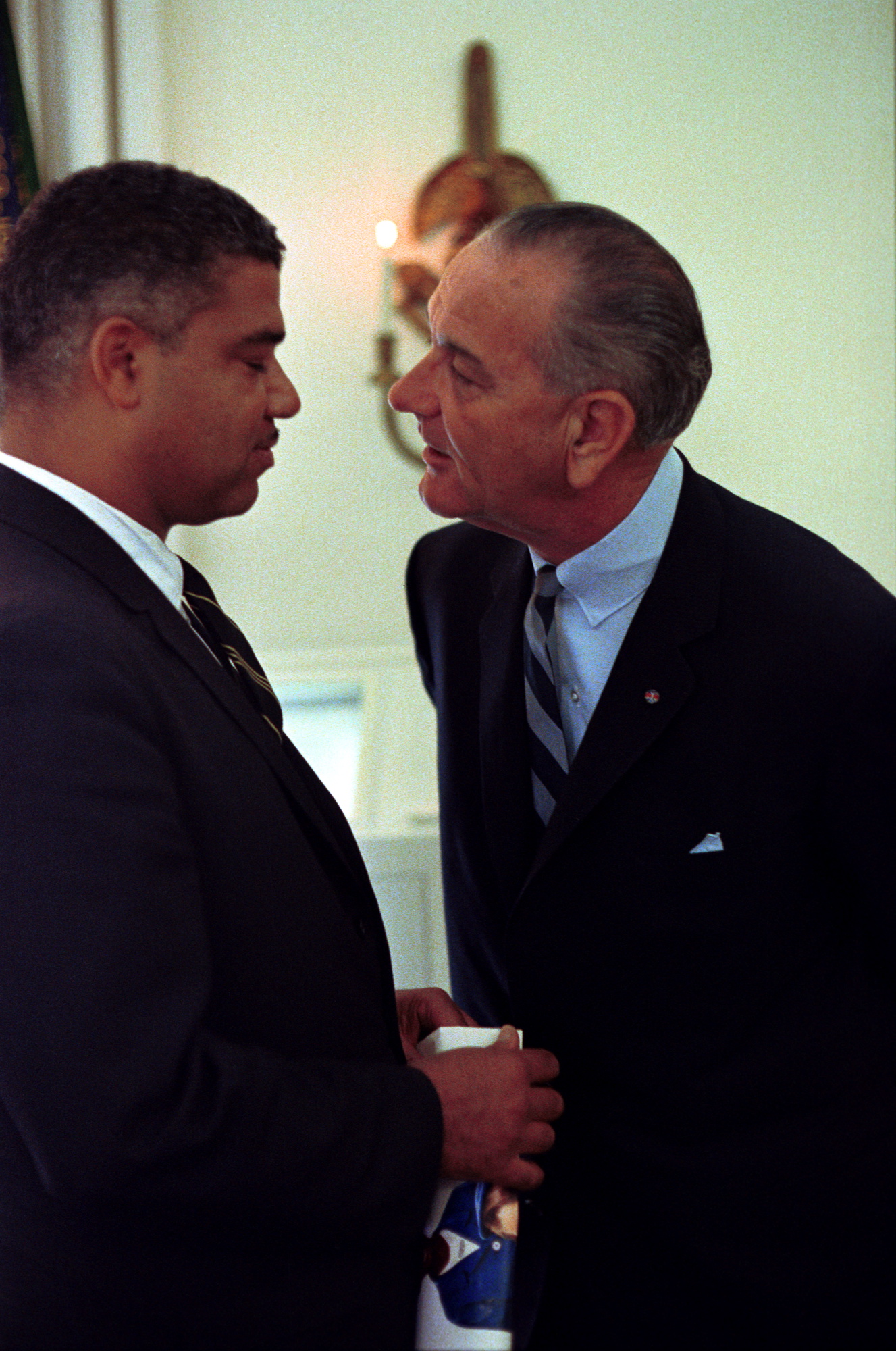
Johnson in discussion with civil rights leader Whitney Young – 1966
THE
CIVIL RIGHTS MOVEMENT GAINS STEAM |
With strong encouragement
from President Johnson, the civil rights movement gains steam – but not without some tragic
moments along the way
|
In Cold War terms, what Johnson was doing seemed
at the time to make great sense. To win the ideological struggle with
international Communism, America was truly going to have to shine. It
would have to conduct a war of its own on any American social blemish
that the Communists might pounce on as a way of embarrassing America,
thus advancing the Communist cause. No more cruel treatment of racial
minorities. But also, no more pockets of poverty, of illiteracy, of
poor health anywhere in America.
"Civil rights" thus began to take on a
broader social definition – not just legal voting rights empowering
individuals to move unrestrictedly in shaping their own personal
destinies, but the rights of everyone in America to enjoy the full
blessings of American citizenship, blessings placed in their hands by a
caretaker government operating above them. These were their
"entitlements" as Americans. And the political machine that Johnson
directed in Washington D.C. was going to be a center of command that
would bring this new system of social entitlements into existence. This
political machine was to be the means by which Johnson's Great Society
would be built.
|
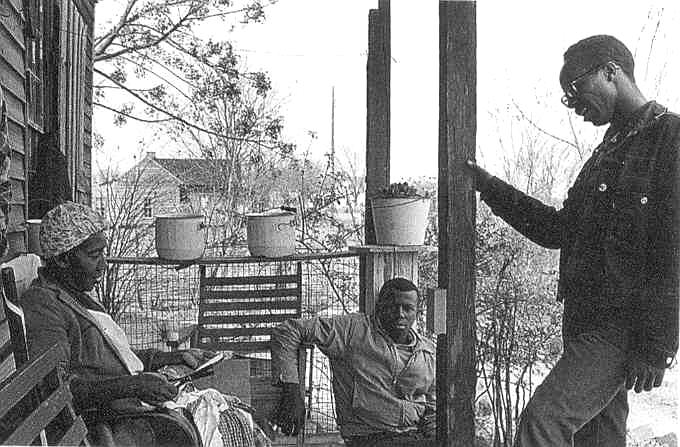
A SNCC worker in Mississippi
during the "Freedom Summer" campaign – 1964
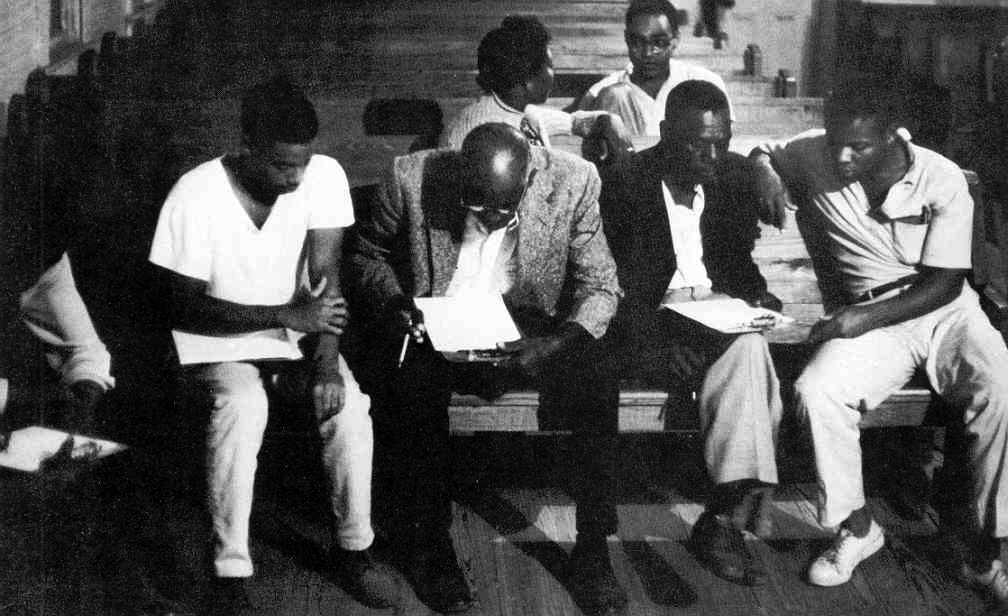
A SNCC-conducted voter
registration
in the South – early 1960s
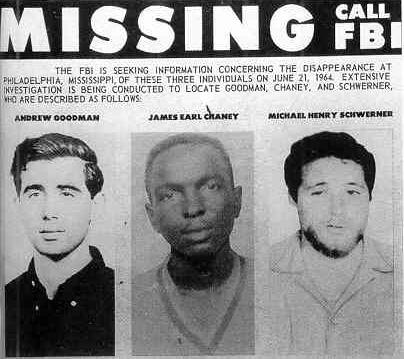
Three civil rights workers
missing in Philadelphia, Mississippi, on June 21, 1964 – whose bodies were
found on August 4.
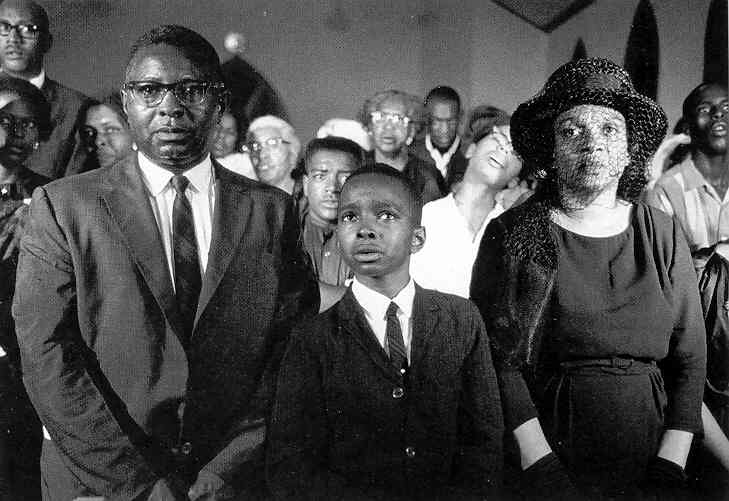 The Chaney family at James'
funeral
The Chaney family at James'
funeral
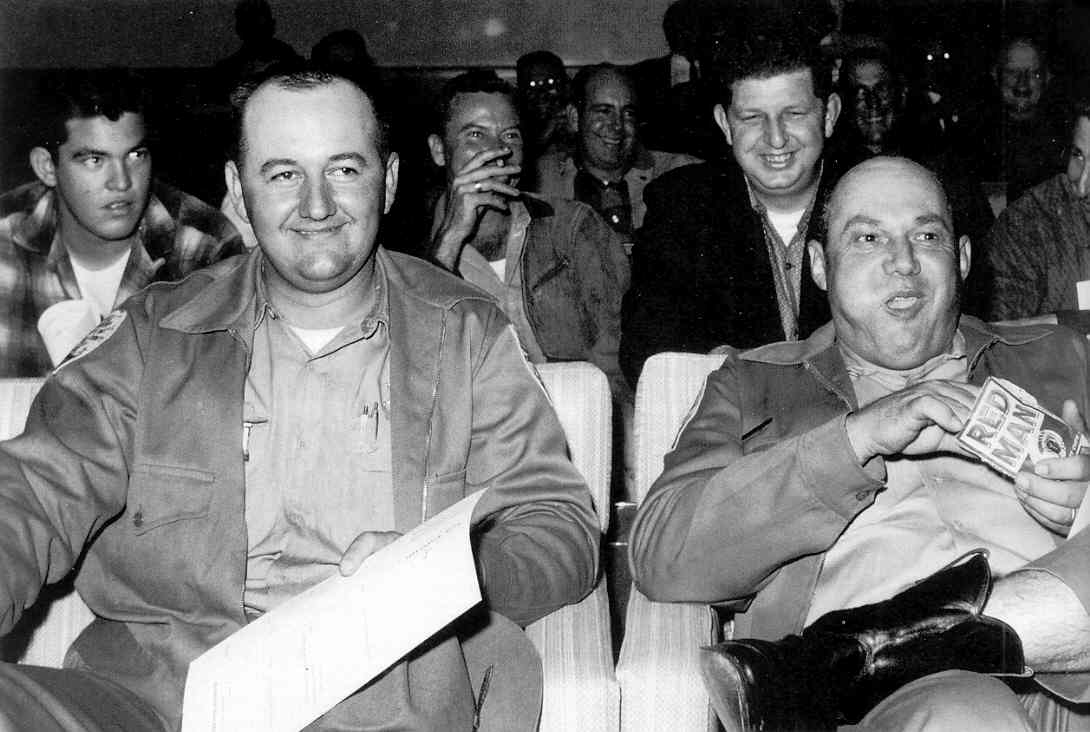
Mississippi sheriff Lawrence
Rainey (right) and deputy Cecil Ray Price on trial for the murder
of the 3 civil rights workers – 1967
Nonetheless despite, and
perhaps because of, Southern excesses, Johnson got Congress
to finally
move on a Civil Rights Bill (1964)
promising equality of treatment of all Americans
in a number of different
areas:< voting, schooling, workplace,
public eating
and entertainment place, etc. discrimination
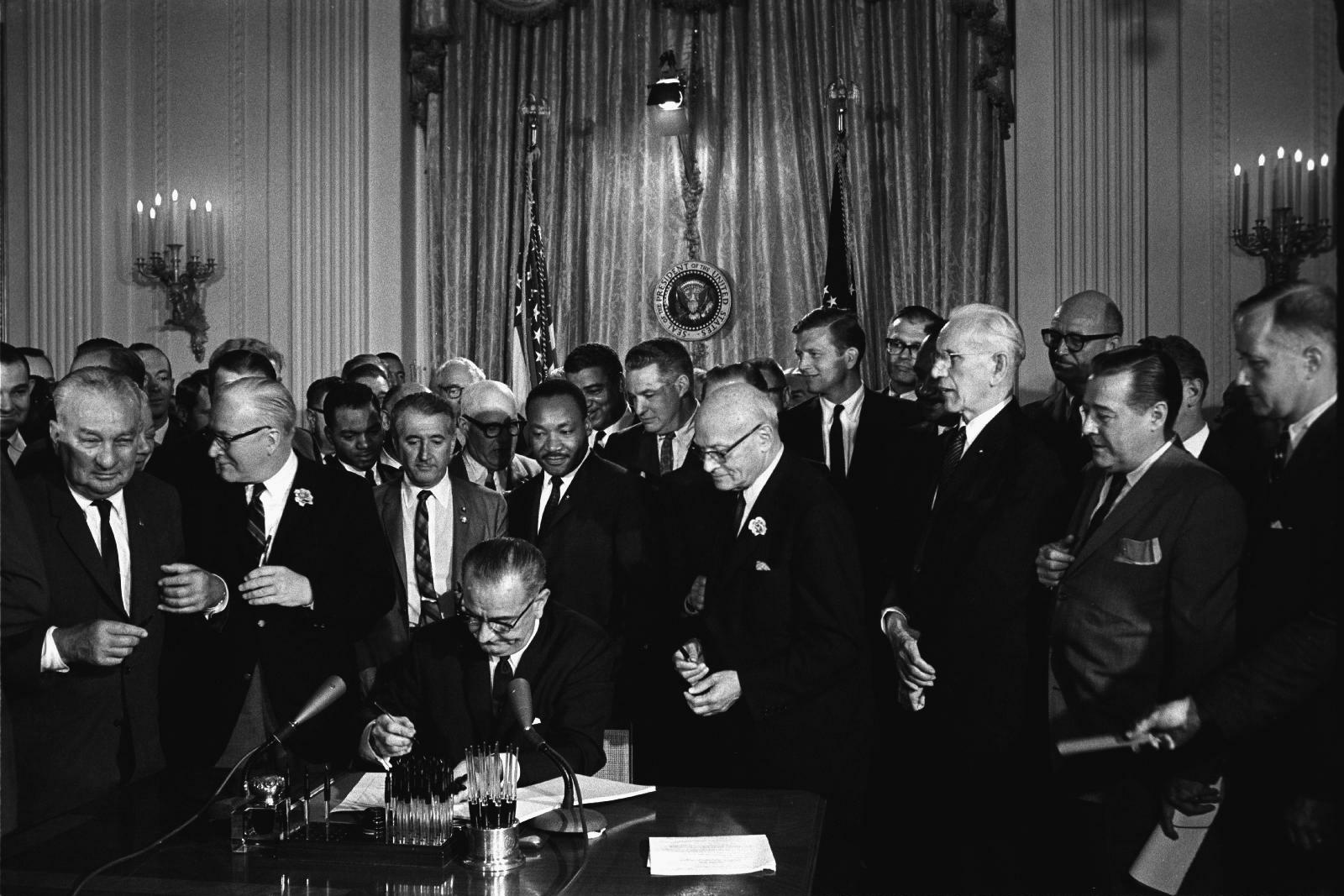
President Johnson signs the
Civil Rights Act of 1964 into law
Cecil Stoughton, White House
Press Office
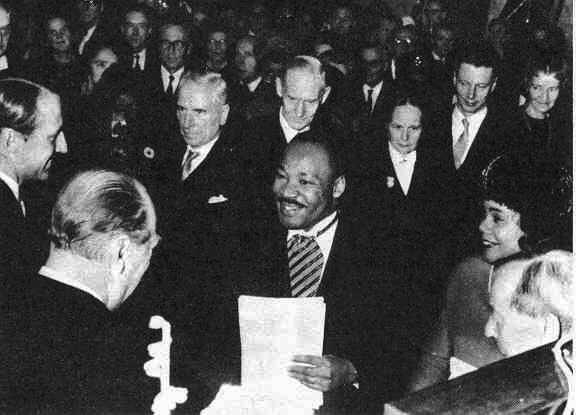
Dr. Martin Luther King, Jr.
receiving the Nobel Peace Prize – 1964 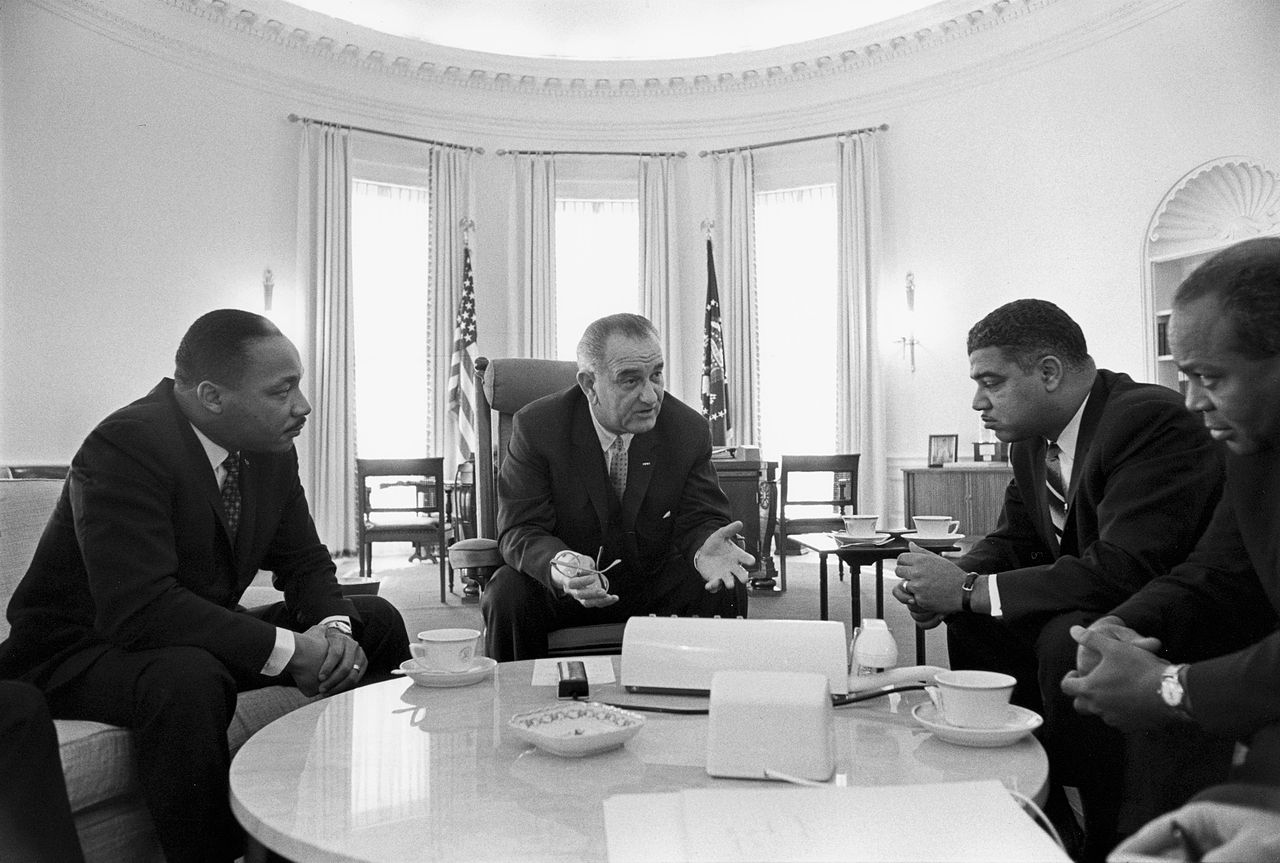
But having a Federal civil
rights law on the books, and getting people to abide by it, are still two different
things in the South. Consequently the struggle
continued:
The March from Montgomery to Selma Alabama – March
1965
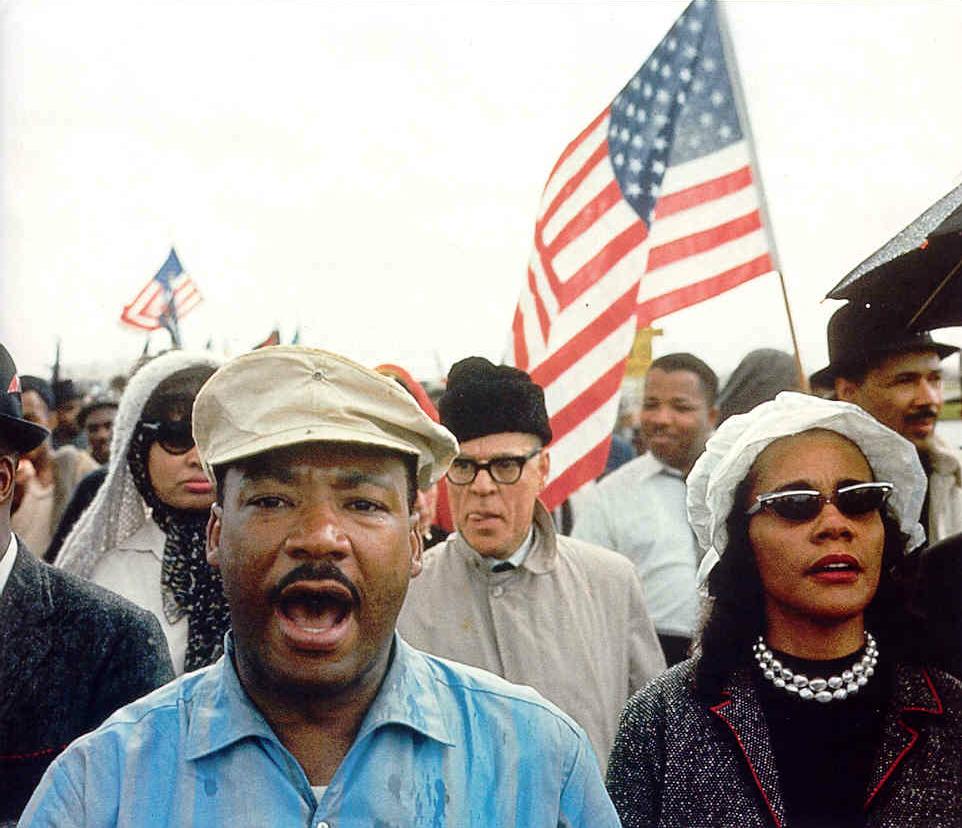
Martin Luther and Coretta
King leading a march in Selma, Alabama, demanding Black voters' rights
March 1965
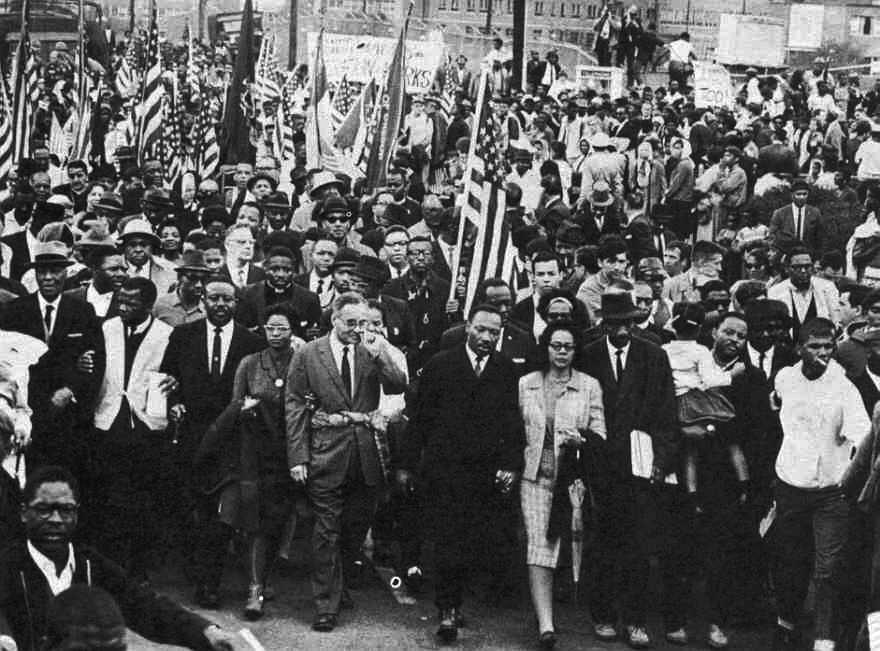
Martin Luther King and 25,000
marchers from Selma to Montgomery – March 1965
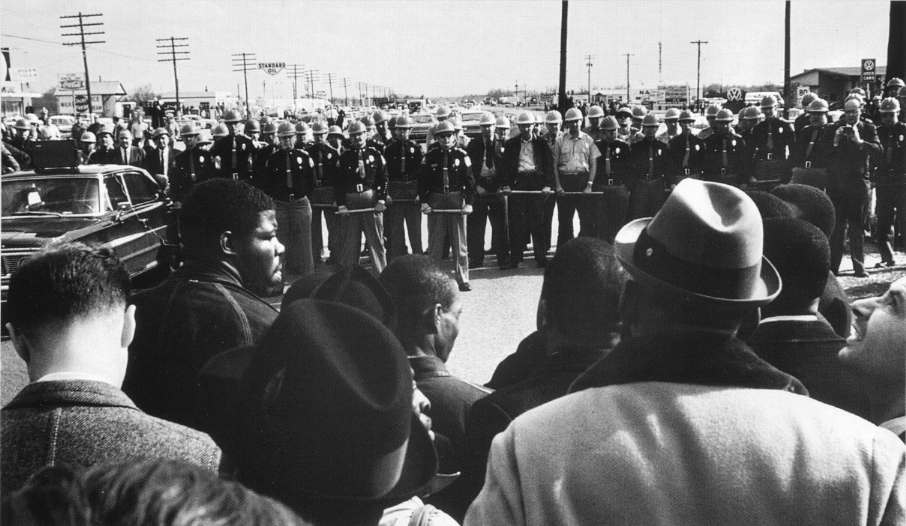
Police outside of Selma,
Alabama, attempting to stop a civil rights march across the South,
March
7, 1965
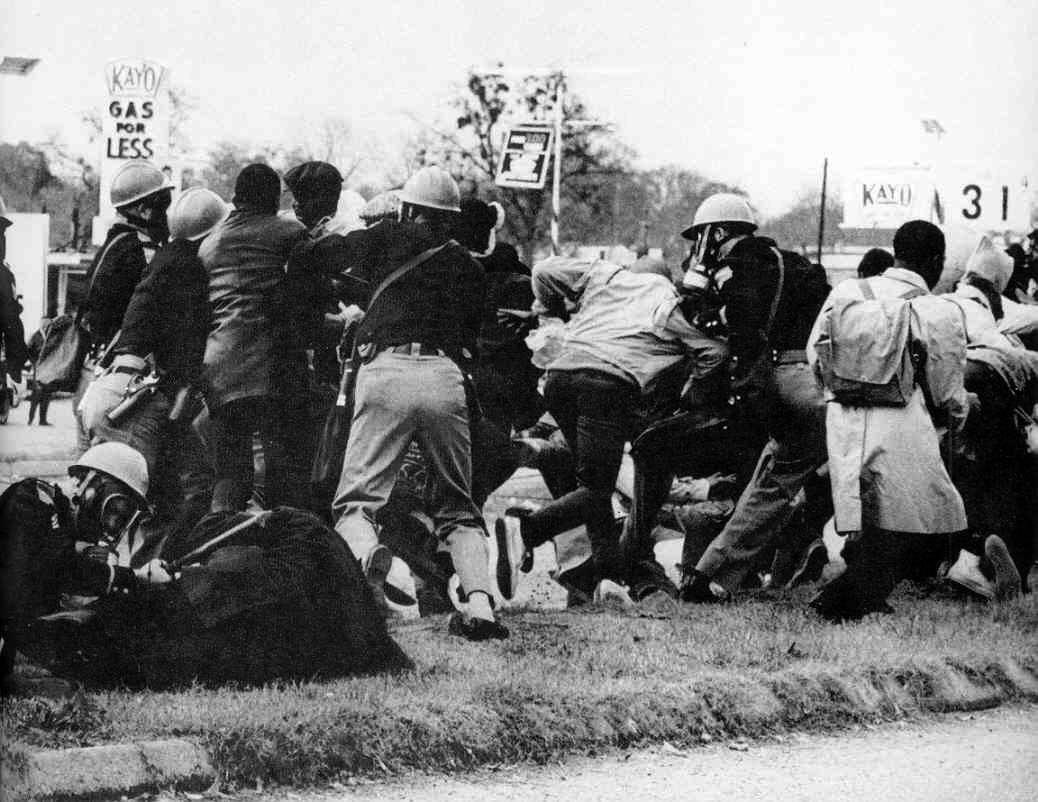
Alabama state troopers attacking
civil rights demonstrators on a Selma-to-Montgomery walk
March 7,
1965
And yet the Blacks began
finally to make considerable strides forward toward equality
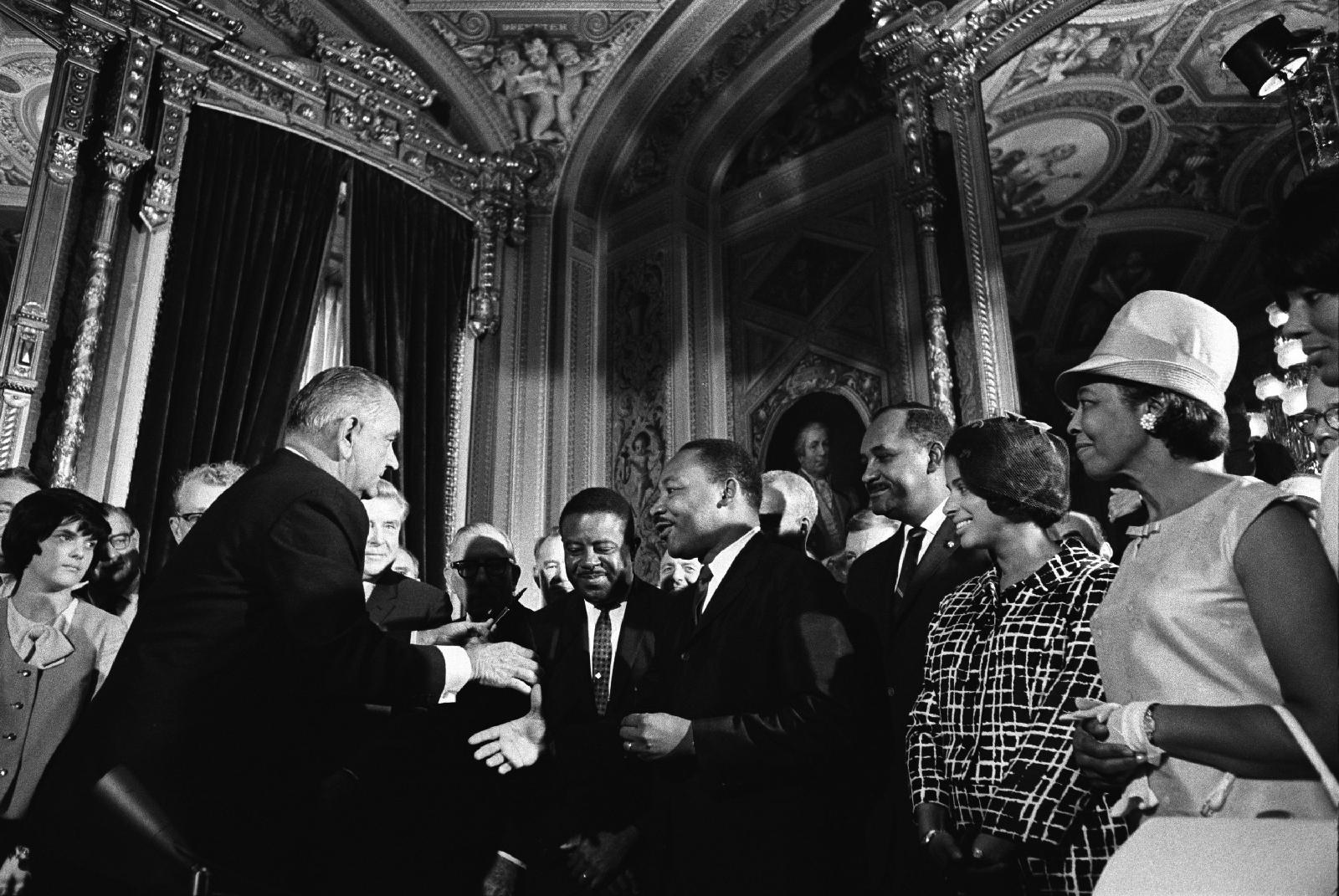
President Johnson, the Rev.
Dr. Martin Luther King, Jr. and Rosa Parks at the signing of the Voting
Rights Act of 1965 (August 6)
This measure attacked the
Southern practice of finding unique ways of disqualifying Black voters
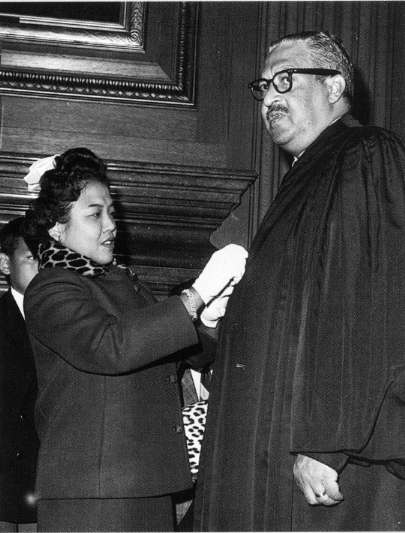
Thurgood Marshall – first
Black member of the US Supreme Court – and his wife Cecilia
JOHNSON'S "GREAT SOCIETY" PROGRAM |
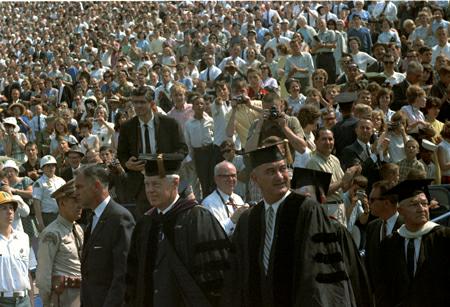
LBJ at the University of
Michigan, May 22, 1964 –
announcing the outline of
his "Great Society" Program
LBJ Library – University
of Texas
|
What Americans did not understand at the time was
that they were handing their political powers, the basis of American
democracy, over to a professionally-run state, which would then govern
autocratically – because supposedly (at least as members of this
autocracy themselves believed) this enlightened super-state was in a
better position to deliver the goods for the Americans than supposedly
they could do this for themselves. Thus Americans began to find
themselves falling into a state of dependency on the powers of
Washington and its officers.
Tragically, this was the same understanding that ancient Republican Rome2
moved to when it transferred the power of the people over to the
efficiently-run Roman legions, with the presumption that this would not
only better serve Rome, but would also better serve the Romans
themselves. And thus the Roman Republic had become the Roman Empire.
And with that, Roman society would fall into a moral laziness, one that
even eventually infected the autocratic leaders that Rome looked to for
correction and guidance.
What America did not know at the time was that they were about to make the same bargain with the powers-that-be in Washington.
Johnson's "Great Society" program
On May 22, 1964, standing before students
graduating from the University of Michigan, Johnson announced the
particular details of his new Great Society program that he was about
to launch. He began by explaining how through invention and
industriousness America had progressed over the generations to being a
rich and powerful society … but how today
we have the opportunity to move not only toward the rich society and the powerful society, but upward to the Great Society.
He
explained that the Great Society would dedicate itself not only to
ending all poverty and racial injustice in America but also to
improving the realm of American education and professional development,
to protecting the country's natural beauty, and to reshaping America's
rapidly developing urban life.
More particularly he stressed, first of
all, the importance of rebuilding an even stronger urban America – not
only materially in the face of such challenges as offering housing for
all, containing suburban sprawl, and improving urban infrastructure,
but also in developing a stronger sense of community within urban
America. He claimed literally that we needed to rebuild the entire
urban United States over the next forty years.
Secondly, the Great Society would look to
the preservation of America's beautiful countryside – threatened by
pollution, overcrowding and the disappearance of its fields and forests.
And thirdly, the Great Society would
ensure that all young Americans were given the opportunity for a
complete education, in high school and college. This required better
teacher training and the development of the love of learning among
America's youth.
Those three items, urban development,
protection of the countryside and the improvement of American education
formed the heart of his New Society proposal. And how was all of this
going to be brought to fulfillment?
Johnson stated:
While our Government has
many programs directed at those issues, I do not pretend that we have
the full answer to those problems.
But I do promise this: We are going to assemble the best thought and the
broadest knowledge from all over the world to find those answers for
America. I intend to establish working groups to prepare a series of
White House conferences and meetings on the cities, on natural beauty,
on the quality of education, and on other emerging challenges. And from
these meetings and from this inspiration and from these studies we will
begin to set our course toward the Great Society.
The solution to these problems does not rest on a massive program in
Washington, nor can it rely solely on the strained resources of local
authority. They require us to create new concepts of cooperation, a
creative federalism, between the National Capital and the leaders of
local communities.
"Democracy from above" by socio-economic technicians
This was a very technical vision Johnson
laid out. It would require special expertise to devise answers to these
social challenges. Johnson made it clear that he would have to assemble the best thought and the broadest knowledge from all over the world
to find those answers for America. The work involved would be done by
White House conferences and meetings. In other words, the inner circle
of power located in the nation's capital would govern this effort to
build America's Great Society.
Johnson claimed that the solution to these problems did not rest on a massive program in Washington but required a creative federalism
between the National Capital and the leaders of local communities. How
he planned to broaden the circle of involvement beyond the White House
conferences and National Capitol meetings, however, he did not explain.
And in the end his Great Society indeed would rest on exactly that – a
vast array of massive programs coming out of Washington, and that alone.
This was a very different definition of
American government than what the nation had been used to. Americans
had accepted this role of a towering central authority during the
horrible years of the Depression and World War Two – as a matter of
grand necessity. But where was that compelling necessity now, something
as dire as a Great Depression and a World War afflicting America – and
thus forcing the nation to look to its national leaders for social,
economic and political solutions? Why this need in today's world for
massive government planning and social control?
But Johnson would effectively use the
powers of the presidency to shift the idea of American government very
strongly in the direction of his own thinking.
And he would take his Democratic Party along with him in this reshaping of America's political dynamics.
America's "government" was now to be
found in Washington, D.C. – not in Omaha or Topeka or Dallas or Denver,
or any of the thousands of small towns across America, or the homes of
the people living in those towns. Under Johnson, it was Washington that
now governed America – and would continue to do so now that Johnson's
technocracy ("government by technical experts") was well in place. No
one was ever going to change America's new political profile.
2It
was also the same mistake that ancient Israel made when it ended its
direct dependency on God and instead placed its dependency on a ruling
monarch – much like the rest of the ancient world. That would briefly
bring Israel great glory – and then soon thereafter the beginning of
its tragic decline.
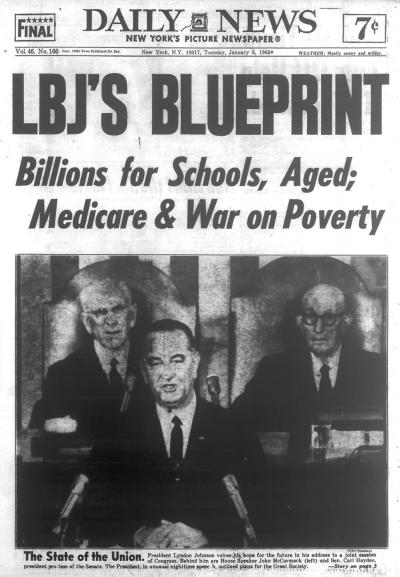
January 1965 – Johnson in his State of the Union address before Congress details even further the content of what he wants to see take shape as his "Great Society" program
AMERICAN POLITICS TAKES A LEFT TURN UNDER JOHNSON |
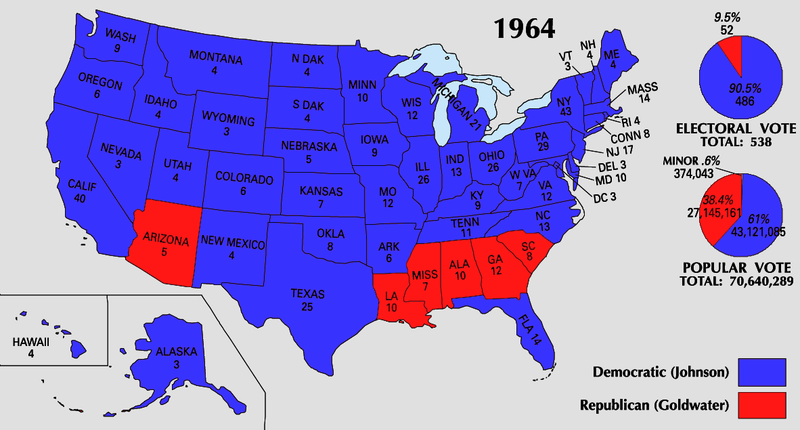
Nov. 1964 – Johnson is elected overwhelmingly to the
Presidency
and holds that position now by his own right
|
The cultural split between the Republican and Democratic Parties
Johnson would rebuild the Democratic Party around
his Big Government vision (some would say "Big Brother" vision, as in
the Orwellian understanding of the term). Ultimately this would serve
to deepen immensely a growing cultural split separating not just
American Blacks and Whites, but also the very Christian middle-class
and very Secular intellectuals. It would also separate the rising
generation of Boomers, and their Vet parents.
One side in this split, now represented
by the Republican Party were the White, Christian Middle Class Vets,
who would become very suspicious of this rapid growth of Washington's
powers, seeing "government" taken from their hands and transferred to
an unchecked Washington bureaucracy – and an equally activist federal
judiciary.
On the other side of this split, now
represented by the Democratic Party, were those social groups, the
"minorities" (or later, "victim groups") as they saw themselves, whom
the Great Society was especially designed to promote. In particular the
Democratic Party enlisted the voting support of Blacks, who clearly had
fallen well behind White society in their ability to work themselves
upward economically and socially. According to the Democratic Party,
Blacks would need a lot of "affirmative action," that is, special
governmental support to compensate for and ultimately eliminate the
disadvantages they experienced in their quest for social status and
cultural importance. They were "entitled" to such special treatment
(federal government programs3)
because of prejudice they and their ancestors had experienced at the
hands of White racism, supposedly now identified with the "privileged"
White middle-class Republican voter. In taking up this line of racist
thinking they conveniently overlooked the fact that it was young White
males who fought and died by the hundreds of thousands in the 1860s
(America's Civil War) so that their Black ancestors might be set free
from the scourge of slavery.
But the category of "minorities" would
come also to include women, some women anyway, at least those who
tended to feel that the professional world (dominated by men) was more
important for them and their futures than the traditional world of
family – and thus would see men as their adversaries rather than as
colleagues in life as they pushed ever deeper into the professional
world.
To this list would also be added gays and
lesbians, Hispanics, American Indians – and even intellectuals
(professors, journalists, media celebrities), soon joined by
college-aged Boomer youth very ready to undertake a great crusade
against the "Establishment" of White, Protestant and "straight" males.
"Democracy" takes on a new meaning
The second half of the 1960s would thus
become a time of massive (and frequently quite violent) change in the
very character of American democracy. "Democracy" would still refer to
the ideal of whom the government served ("the people"), but it would no
longer refer to the ideal of who it was that actually directed such
service. Government would take on the character of rule more by elitist
decree and less by popular consent and active support. Increasingly
"the government" would become less and less the public will and more
and more the will of professional politicians filling the growing ranks
of unelected (and virtually unremovable) officials directing the very
expensive and very expansive federal bureaucracy ... and the equally
expansive (in terms of political-cultural scope) federal judiciary.
But supposedly such government by the legal and technical experts would "progress" greatly the democratic character of society.4 But Marxism-Leninism (Communism) also made the same claim.
And indeed, Johnson's Great Society
program involved a distinct move toward Socialism and away from the
Puritan-founded grass-roots democracy that had been the very political
foundation of America, at least in the American North and West, and
with the outcome of Civil War a century earlier, becoming finally the
political ideal of all the country.
Now under Johnson's skillful political
management, the Democratic Party would identify itself as the party of
the "Liberals," meaning (in other social contexts such as that of
Europe) the "Socialists." Furthermore, most of Johnson's work would
remain intact after his departure from office at the beginning of 1969,
to the extent that the massive buildup of government officialdom in
Washington, D.C., and the governmental financial debt that went with
it, not only remained in place but would continue to grow in the years
ahead – a social dynamic carefully defended and protected by the mass
of political technicians making up this huge and unshakable Washington
Establishment.
"Liberal" intellectuals retake the cultural high ground in America
American intellectuals had been under
fire during the 1950s as being questionably patriotic because they did
not adhere closely to the American Middle-Class cultural system so
dominant everywhere in the nation. Now in the 1960s – with memories of
World War Two and the considerable sacrifices that Middle America
undertook to save the nation now fading from view – these alienated
intellectuals saw their chance to retake what they thought was their
natural position as national leaders. Intellectuals now saw before them
the rise of a newly emerging political culture, one directed not by
middle-class citizenry but by professionals from the upper or
"high-brow" reaches of American culture. Not only were these American
intellectuals detached from middle-class values, they were strongly
opposed to them and sought their removal from the central position in
the American culture that they had occupied for centuries.
Now a newly rising federal state provided
a particularly useful place for them, as trained social managers, to
put their new cultural revolution into effect (the nation's press and
universities being additional platforms from which to conduct this same
intellectualist revolution).
A cultural split within American academia
A result of this gathering social shift
in the 1960s was a huge battle which also began to develop at this time
in the various social science departments (sociology, economics,
political science) of America's universities. This battle pitted a body
of rising "social scientists" against the old guard of professors who
approached their subjects on a rather historical/philosophical basis.
This rising group of quite idealistic scholars were typically the
younger members of the department, very optimistic about their "social
science" that they intended to bring to the study of society, and very
contemptuous of the old-fashioned approach to the subject pursued by
the older members of the department. These older professors had long
approached the study of politics more as a matter of narrating
historical events which offered not only a laboratory of social
examples to draw lessons from but also moral or inspirational insights
into political behavior in general. But for the newly rising group, it
was time to move past such an antiquated methodology.
The younger academics called themselves
"Behaviorists," taking cues from the science of psychology which
claimed to be making tremendous progress through the new behaviorist
theory in putting human behavior under experimental laboratory analysis
(with marvelous mathematically precise results that could be presented
as statistical charts and graphs), and thus under better control by the
doctors of psychology.
The young social scientists had the same
vision: to approach the study of social dynamics from a rather clinical
or experimental angle. Obviously, however, no one can put an entire
society under a carefully-controlled laboratory experimentation. So
what they proposed to do was to uncover great social truths by
conducting carefully-controlled experiments in small-group social
behavior. But how they exactly planned to expand small-group theory to
serve mass-group theory (the dynamics are actually quite different) was
never explained – nor for that matter ever discovered. But these young
idealists had not yet advanced to the stage of confronting such social
reality quite yet. In fact, they were not in a hurry to get there
either!
Nonetheless, they were religiously
certain that they would eventually uncover the truly scientific (purely
"mechanical") principles of the behavior of whole societies, principles
that would allow the doctors of society to better control society's
dynamics – in order to institute proper political-social-cultural (even
intellectual and spiritual) reform of society, the very kind of
approach that Johnson's Great Society Program was calling for. Indeed,
these young and energetic academics were looking forward to the
opportunity to become consultants, or even full-time directors in the
building of this new Great Society. They were quite certain that their
new "social science" would allow them to manage society on a much
better basis, ending the haphazard traditional approach which seemed to
them to offer little of substance in the effort to perfect society.
These young Behaviorists took their
inspiration from their ranks of young economists, already being trained
and prepared to manage not only business firms or corporations but the
financial and industrial systems of entire countries (and the rising
international economic system led by American capitalism). The young
Behaviorists of all social studies fields were certain that they could
soon achieve in their own social studies fields the goal of developing
something equivalent to Samuelson's Economics, the economics textbook
of the 1960s found in virtually every American university (and many
European universities as well). Samuelson's textbook was a virtual
manual on good economic management. It offered charts, graphs, tables,
algebraic formulae that seemed to cut through the mystery of wealth and
its creation and distribution, making economics truly a science.
Supposedly such precise, mathematically-derived insights into
economic behavior could finally solve not just the problems of
the rise and fall of market trends, but the very matters of wealth and
poverty themselves. Economists (who flocked to Washington in huge
numbers) were certain that they possessed the factual foundations to
truly bring the Great Society into being – a society of vast prosperity
and economic justice.
From the point of view of the other
experts in the fields of the new social science, this could, and
should, be done in their social-intellectual disciplines as well. They
were also going to make their contributions to the prosperity and
justice that awaited the development of the Great Society.
And indeed, as it turned out, they would
soon (very soon) have a front seat in observing exactly how all this
new "science" was going to bring America to the state of social
perfection.
3The
Democratic Party's extensive government programming – which gave the
multitudes of new government "experts" their jobs as well as their
sense of political importance – made this army of technocrats also
major supporters of the Democratic Party. Republicans who came to
Congress to cut back on the nation's massive governmental expansion
would thus automatically find themselves opposed, even effectively
undercut, by their natural opponents in Washington's technocratic "deep
state."
4Actually,
this was not a new interpretation of "democracy." It paralleled quite
closely Wilson's and FDR's understanding of the concept as well.
THE CONTINUING ATTEMPT TO PROTECT RELIGION FROM SECULAR/JUDICIAL REGULATION |
|
Increasing "judicial activism"
And the federal judiciary would also get drawn
ever more deeply into this new political attitude. Regional Circuit
Court and national Supreme Court Justices would take up the cause of
legal progressivism over the objection of a smaller group of
"originalists" in the judiciary who were opposed to such a development.
Judicial activists would not merely sit in judgment of the proper
application of the law, but move to reshape those laws, even laws
properly passed by Congress and signed into law by the President, when
various federal judges felt that circumstances warranted a more
"progressive" application of those laws.
In short, the federal judiciary was
becoming not only the Supreme Court but also the "Supreme Legislature"
of the United States, with no known checks available to block such
judicial overreach, except for (usually, Republican) Presidents to
appoint more originalists to the bench whenever vacancies occurred.
Thus the battle in the U.S. Senate over confirming new presidential
appointments to the federal judiciary would become increasingly bitter
as America moved down the road of judicial activism. The very idea of
American democracy was at stake in those appointments.
A second effort to protect religion from Federal regulation
With Representative Celler's success in
undercutting the momentum of the Becker Amendment in the House, the
Congressional effort to back the Supreme Court off its anti-prayer,
anti-Bible-reading position in public education now moved to the
Senate. In March of 1966, the Republican Party's Senate Minority Leader
Everett Dirksen of Illinois took up the cause by introducing in the
Senate a constitutional amendment (the Dirksen Amendment) similar to
the failed Becker Amendment.
In the time period since the failure of
the Becker Amendment, Christian denominations had continued to struggle
in deciding where exactly they stood on this matter of prayer and
Bible-reading in their schools.
In general, the denominational leaders and national officials still
seemed opposed to any such Amendment, continuing to claim that the
Court was actually trying to protect the right of prayer and
Bible-reading in America, not undercut that right. But clearly the
Christian rank-and-file laity were seeing things quite differently.
Even the Baptists, with a long history of wanting to keep the affairs
of religion and state entirely separate in order to protect their
religion (not protect the state), found themselves drawn into this
controversy as well. At their 1964 summer meeting, delegates to the
Southern Baptist Convention argued heatedly over the matter, finally
finding a compromise – which probably resolved nothing on the matter.
Over the next months the issue simmered
on the back burner, as other issues (civil rights, Johnson's Great
Society Program, the Vietnam War) received most of the country's focus.
But by 1966, Congressmen were receiving so many letters of Americans
still concerned about the matter of prayer and Bible reading in their
schools that Dirksen (after having helped put much of the civil rights
legislation through to successful adoption) turned his attention to
this religious matter, he himself being a very strong believer in the
importance of prayer in the life of America and its people.
Debate in the Senate followed typical
Liberal-Conservative lines, as outside groups also lined themselves up
for or against the Dirksen Amendment:
Nothing
contained in this Constitution shall prohibit the authority
administering any school, school system, educational institution or
other public building supported in whole or in part through the
expenditure of public funds from providing for or permitting the
voluntary participation by students or others in prayer. Nothing
contained in this article shall authorize any such authority to
prescribe the form or content of any prayer.
Debate
swung back and forth as the Senators attempted to fathom the extent of
national support or opposition to this amendment. Once again, tending
to oppose any such amendment were most of the denominational leaders,
their voices presented strongly through the organization of the
National Council of Churches. On the other hand, the massive number of
letters sent to Congress indicated a very strong support of the
amendment by the laity, though exactly what percentage of the laity
(including local clergy) was in favor of the amendment was never a
clear matter. Certainly there seemed to be a majority in favor of the
amendment. But how big was that majority?
In
September of 1966 it was time simply
to bring the matter to a vote before the full Senate. The results were
49 in favor (nearly all Republicansand most of the Southern Democrats)
and 37 opposed (3 Republicans and the rest Democrats) to the amendment.
5 Failing by nine votes to gain the necessary 2/3rds vote for a constitutional amendment, the matter died.
But the moral-spiritual division that had
developed over this this issue of prayer (and the place of God) in the
development of America's future generations did not die. It merely
clarified how deeply the nation was split on a matter of fundamental
importance to its very moral-spiritual character.
5Still
to this day it is not clear why the Democrats are so readily opposed to
the role of Judeo-Christianity in the life of the nation.
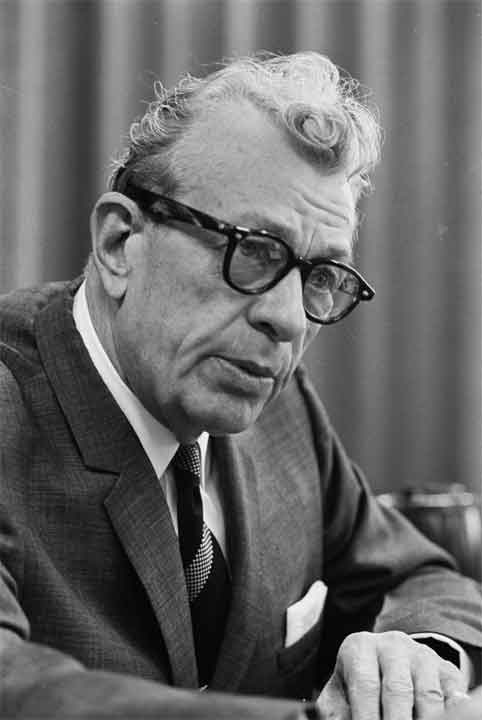
Senator Everett Dirksen
BUT IRONICALLY, RACE RELATIONS SEEM TO WORSEN RATHER THAN IMPROVE WITH AMERICA'S REFORMS |
|
The Blacks' "Revolution of Rising Expectations"
\Also at this same time another major shift in the
American cultural profile was taking place, this one within the Black
community. Young Blacks were growing more radicalized as shifts in the
racial status quo began to occur. Despite quite visible progress in
getting a cultural shift moving in America – one attempting to make way
for Blacks to come into full and equal participation in American
society – it was never fast enough for young Blacks. This rising group
of young and quite militant Blacks was beginning to voice its deep
hostility to the White society around it, a White society that it
claimed was still standing in the way of Black development.
By 1965 that hostility was taking the
form of attacks on White businesses in Black neighborhoods, even
pillaging and burning them in demonstration of the outrage that was
growing in their hearts against White injustice. And the crime rate
within Black communities began to skyrocket. The social order seemed to
be crumbling rather than improving with the government's efforts to
better the lot of Blacks in America.
Idealistic or Liberal Whites could not
understand this strange response of the Blacks to White efforts at
reform. They probably had never heard the term "the revolution of
rising expectations." They did not understand that people long
compliant to oppressive authority do not automatically rise up to throw
off their chains just because the oppression is great.
Idealists (such as, for instance, Karl
Marx) however believed/believe religiously that this was how the noble
human spirit would automatically and inevitably produce the great
revolution that would one day usher in the class-less, state-less,
totally egalitarian, totally voluntary society (voluntary with respect
to a person's willingness to work hard for the common good). As
oppression worsened, people would begin to move automatically toward
revolution, even violent revolution.
But things just do not work out that way in the real world. People
actually are quite able to accommodate themselves to their chains. This
is not a very noble picture of human nature. But it is a realistic
picture. Action moving people to change things does not happen until
the people begin to have reason to believe that change is possible.
They will not throw off the way they have learned to live with
oppression until they are fairly confident that change, that some kind
of release from the oppression, is possible.
Then once they see the system bending or
cracking, they begin to become bolder in their push for change. As the
oppressing system begins to back down, they then easily become irate
and indignant at the injustice of the way things were and impatient
waiting for reform or change. Once they finally see that things are
moving in their favor, they then become defiant, even heroic in that
defiance. That's when they finally become truly "revolutionary." But
not until then.
Thus the more that the White society
began to accommodate Black interests in the 1960s, those interests
began to gather momentum, until they became truly a storm of passion.
It was not because just at that point that oppression was just starting
to get severe, but because at that point the severity of it seemed to
be lifting. Then all the impatience at the slowness of the process of
change began to set in. Then the anger mounted, then the violence
picked up. This was the phenomenon the Whites were observing, rising
Black militancy in response to the Whites' honest interest in seeing an
improvement in the Black situation.
But the Whites had no idea of why the
more they tried to improve things, the more indignant and resentful the
Blacks became. It was just human nature. But American Idealists had
(and still have) very little accurate insight into human nature. They
had made man into a rational, loving man-God. But this man-God was
behaving neither rationally (as Idealists understand "rational") nor
lovingly in the American streets as the 1960s rolled along.
White guilt vs. White bitterness
The White effort to make sense of their
Idealistic universe gradually took the form of either 1) a rising White
self-hatred and the deep need to apologize for their ancestors having
left such a horrible legacy of racism (the typical response of
self-shaming Liberal intellectuals and Boomers), or 2) a rising White
bitterness about the Blacks' inability to maintain a decent sense of
law and order among themselves (the typical response of the Vets).
Political lines were beginning to be drawn up for battle as the
situation in America worsened.
At the same time, America was now
witnessing a deepening of the bitterness of Black America as high
expectations for rapid progress in Black social development failed to
be met immediately by the "system." Young Blacks now turned on the
system in anger, looting and burning the world immediately around them.
In 1965, the Watts section of Los Angeles was looted and burned, also
involving thirty-four deaths in the accompanying violence, done so to
the refrain of "Burn, Baby, Burn" ... with police sirens answering back
in refrain as Black Power advocates were carted off to jail, either as
self-sacrificing heroes or dangerous criminals, depending on which side
of the ideological divide you found yourself on.
The arrest of a Black cab driver in
Newark, NJ in mid-July of 1967 also set off a rampage by Blacks in that
city. Firebombs and looting degenerated into sniper shooting. A curfew
was imposed on the city, which slowly restored order. But eleven people
had been killed, 600 wounded or injured and whole sections of the city
were completely gutted by fire.
When several days later a prescheduled
National Unity Conference was held in that city, the language was one
not of unity but of declared war. Black power advocate H. Rap Brown
urged the gathering to "wage guerrilla war on the White man." Los
Angeles Black Nationalist Ron Karenga stated "Everybody knows Whitey's
a devil. The question is what to do about it."
Meanwhile, moderate Black leaders such as
Dr. Martin Luther King, Jr., Roy Wilkins, and Whitney Young, Jr.
avoided the conference.
In late July, violence broke out in
Detroit. Learning from Newark, Detroit mayor Cavanagh immediately
called in the National Guardsmen. But seven thousand Guardsmen,
complete with tanks and armored cars, could not restore order. Governor
George Romney (who was understood to be a potential Republican
candidate for the Presidential election in 1968) contacted President
Johnson for assistance. Johnson held back until Romney confessed before
the public that he had lost control of the situation. Then Johnson sent
in U.S. paratroopers to retake the city, house by house, block by
block, similar to a Vietnam military action. When a week later the
troops had brought Detroit back to order, forty-three people had been
killed and over a thousand injured.
Meanwhile the violence spread to New York
City where a 28,000-man police force with experience in riot control
restored order to East Harlem after three nights of violence. Two
people were killed.
H. Rap Brown had in the meantime moved on
to Cambridge, Maryland, and following a Black-power rally there, the
town was subjected to looting and arson. Brown was arrested for
inciting a riot. As he was led away by FBI agents, Brown challenged:
"We'll burn the country down."
Faced with this confusing and mounting
crisis, Johnson appointed a study commission to investigate the root
causes of the violence. What it announced in its preliminary report in
late February of 1968 indicated a situation of high expectations among
the Blacks for extensive social reform, met with little practical
chance that such improvements would actually come about quickly. Also,
the inner cities abandoned by White flight to the suburbs left Blacks
who had migrated to the northern cities with no jobs and a rapidly
deteriorating urban infrastructure. Educational levels were very low,
with poor and dangerous schools able to provide no remedies.
It quickly became the assumption within
Johnson's Great Society government that huge amounts of governmental
money were going to have to be poured into the inner cities where
Blacks had congregated to correct these problems of jobs, schooling and
housing. Clearly, Johnson's government had no expectations that the
Black communities would be able to address or correct these social
challenges themselves. They would have to come to depend on government
"assistance" – on a massive scale – if any serious improvement in the
Black social situation were ever to occur.
|
Malcolm X,
1925-1965
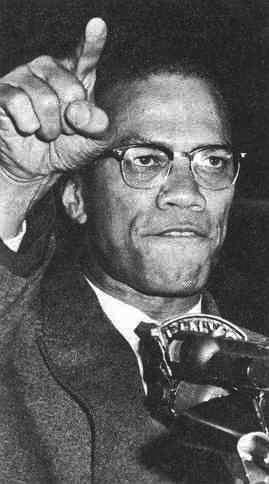 Malcolm
X
Malcolm
X
Blacks demonstrate their
new freedoms by torching the world around them (what exactly was the logic
in this behavior?)
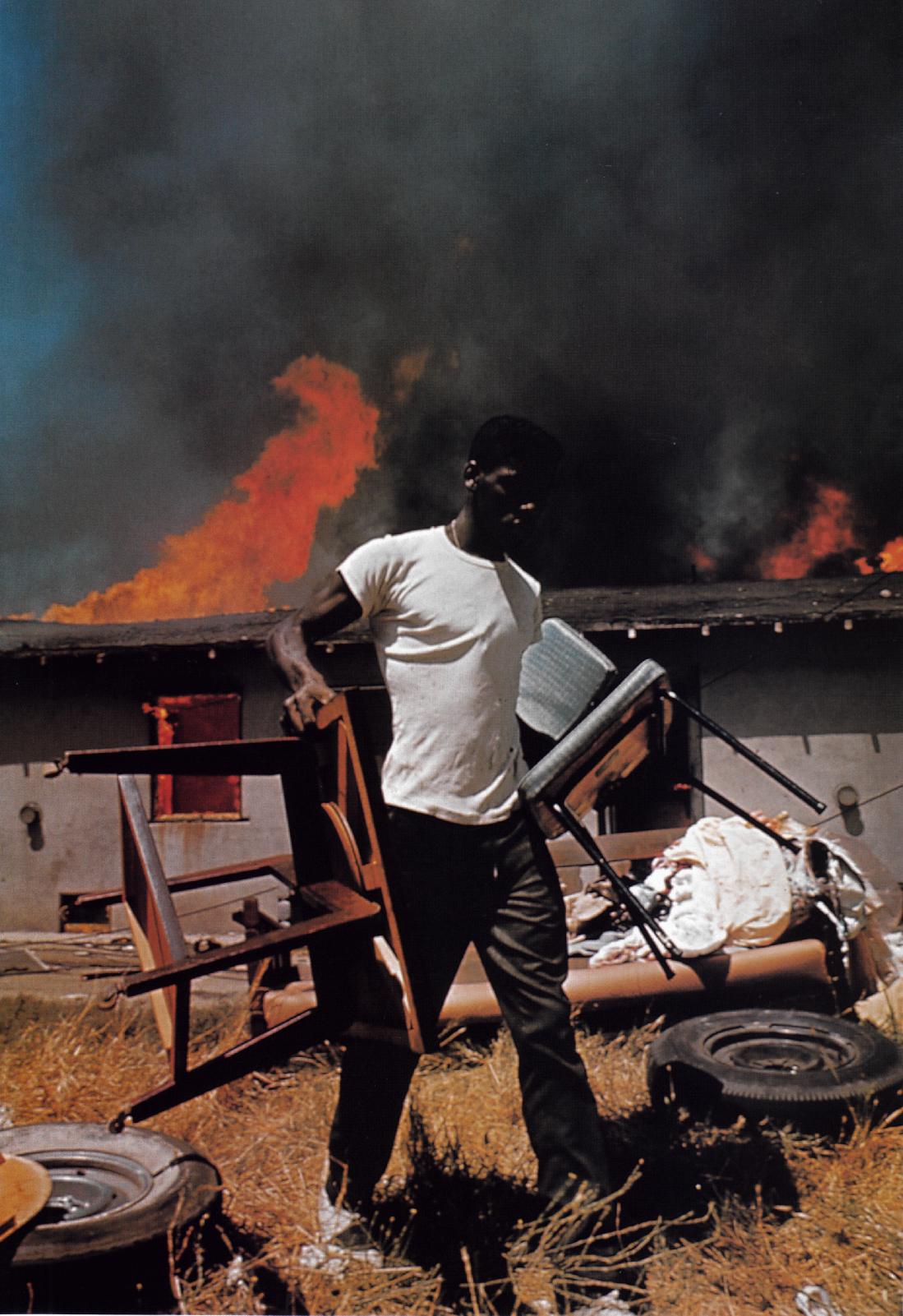
Rioting and arson in Watts
- 1965 (less than a week after the passing
of the Voting Rights Act)
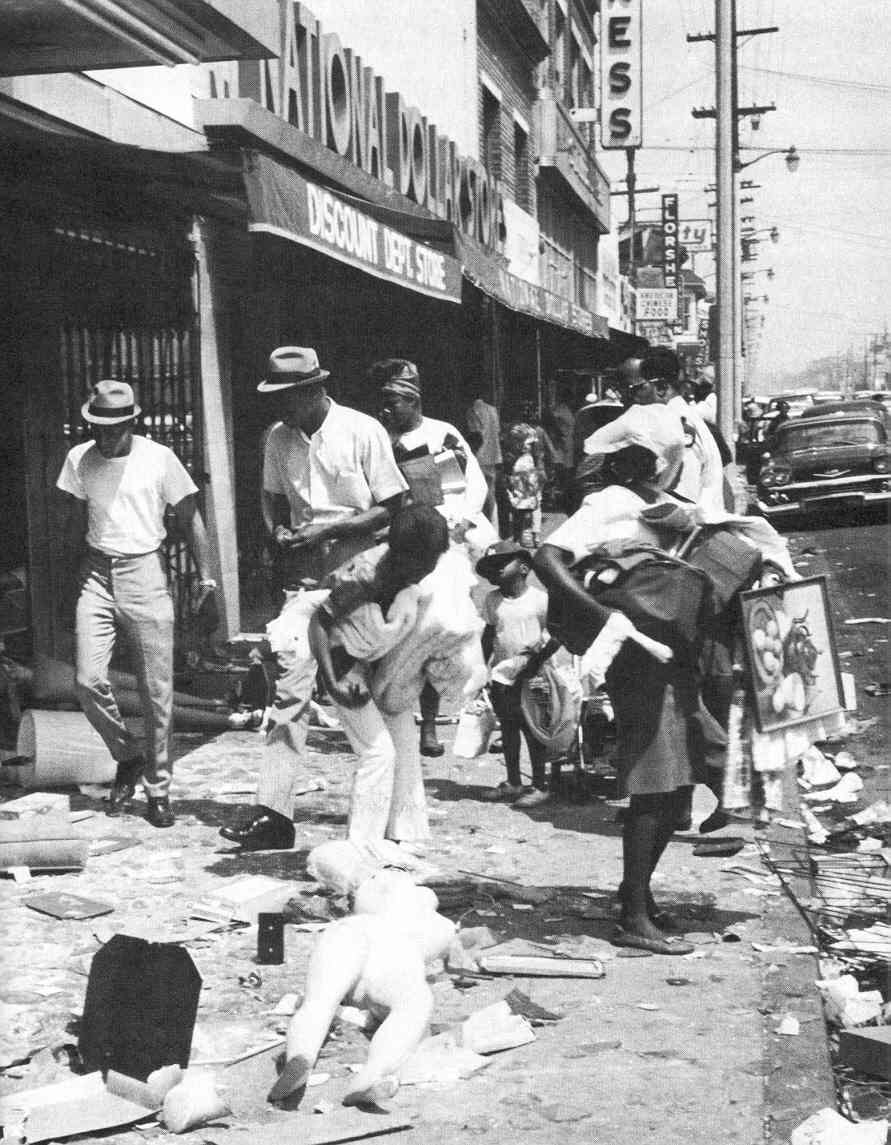
Black looters in the Watts
section of Los Angeles – August 1965
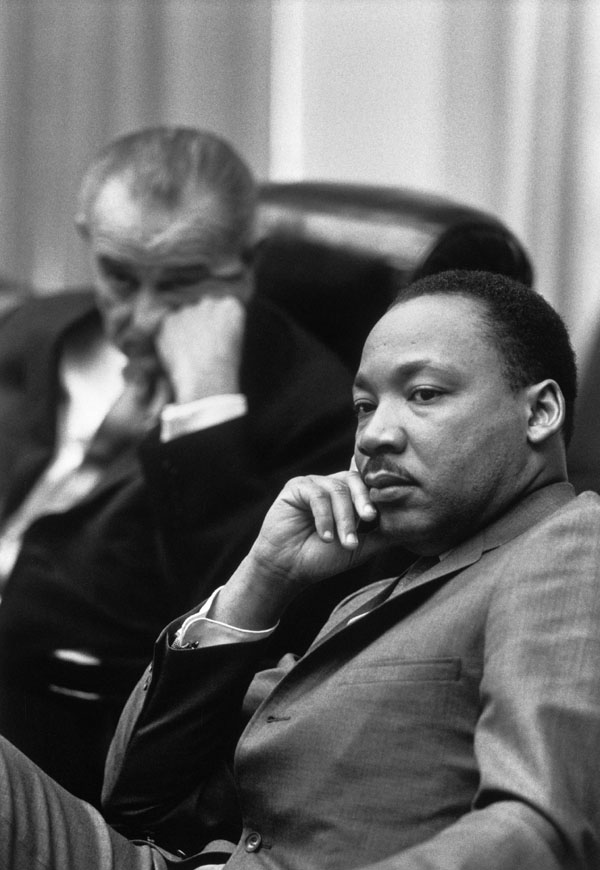
Rev. Martin Luther King,
Jr.; President Lyndon Johnson in background (the breakdown of social
order was not at all what either of them expected or wanted
the civil rights
movement to develop into)
By Yoichi Okamoto, Washington,
DC, March 18, 1966
Lyndon Baines Johnson Library,
National Archives
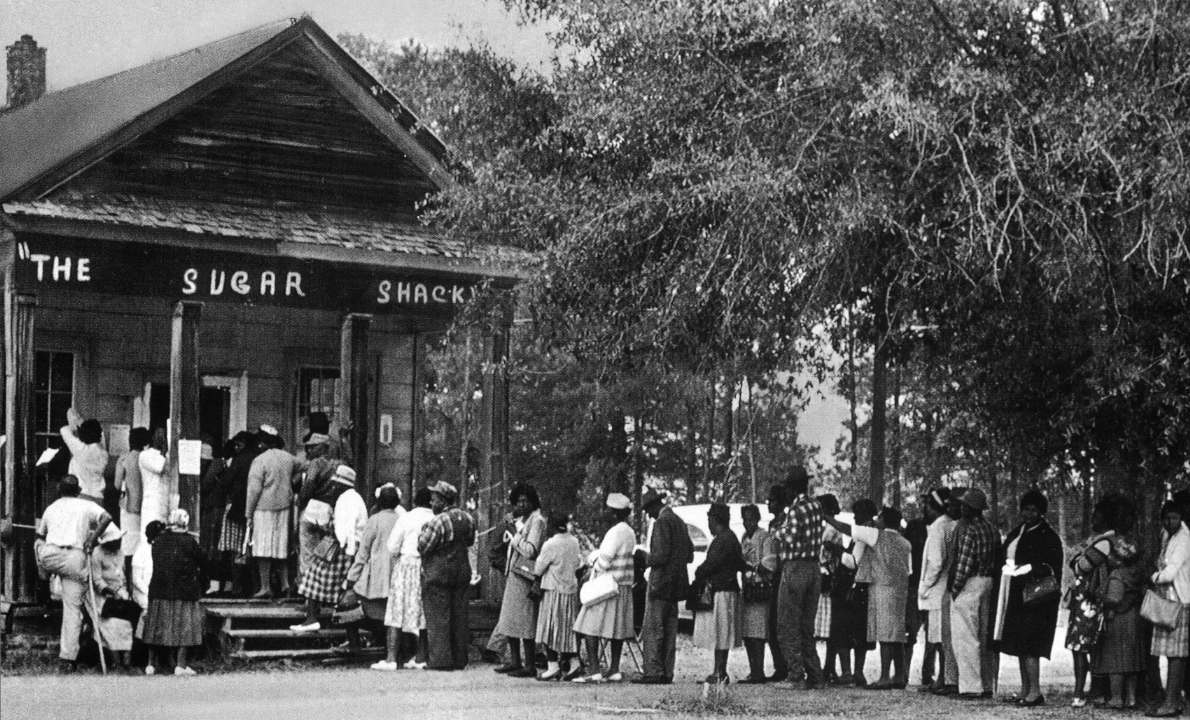
Blacks lining up for the
vote in rural Peachtree, Alabama – May 3, 1966
For many young Blacks, 1967
was yet another summer for looting and burning (giving rise to the new
mantra: "Burn baby, burn") 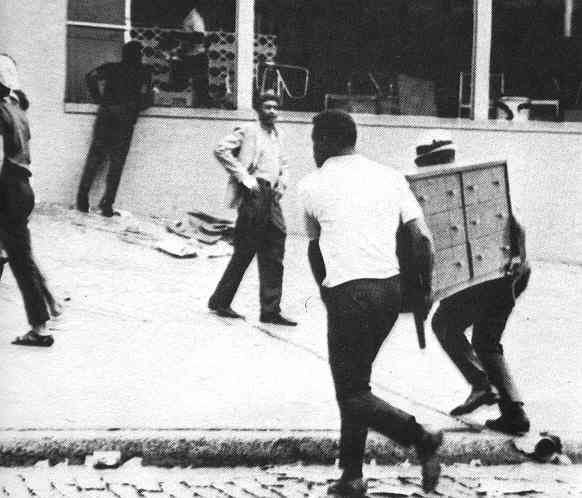 Looters in Newark's riots
– mid-July 1967
Looters in Newark's riots
– mid-July 1967
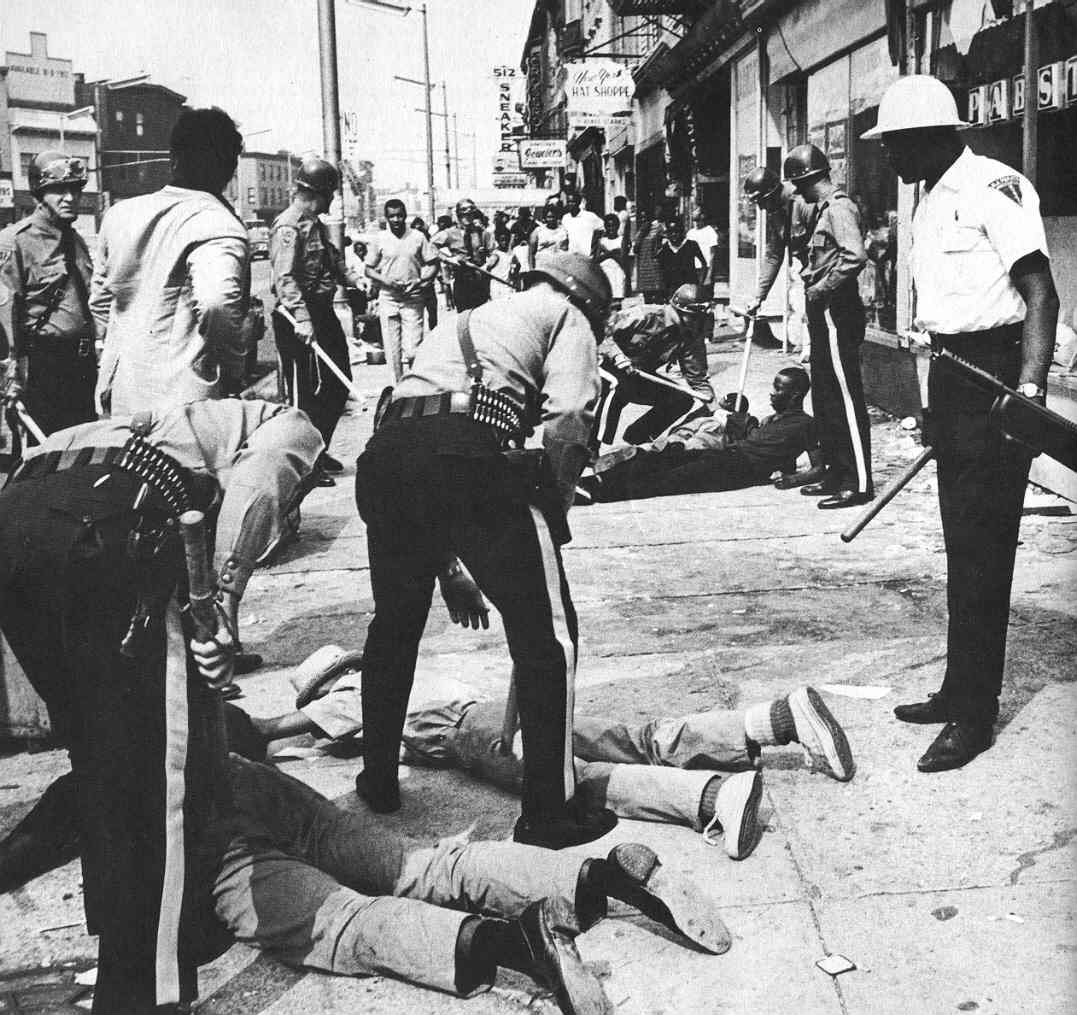
National Guardsmen and police
arresting looters in Newark's riots – mid-July 1967
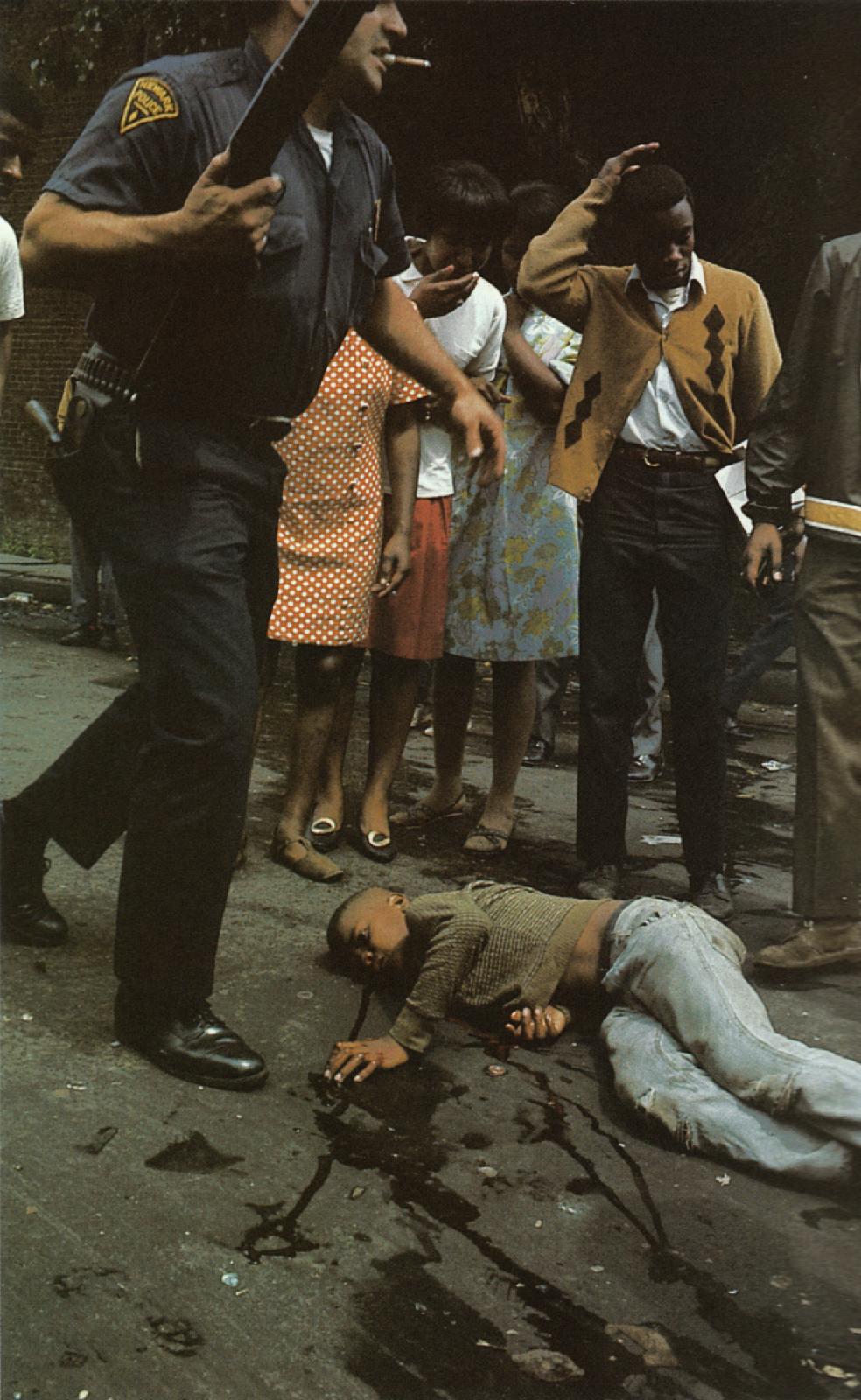
A boy wounded in the Newark
riots – 1967 (26 died)
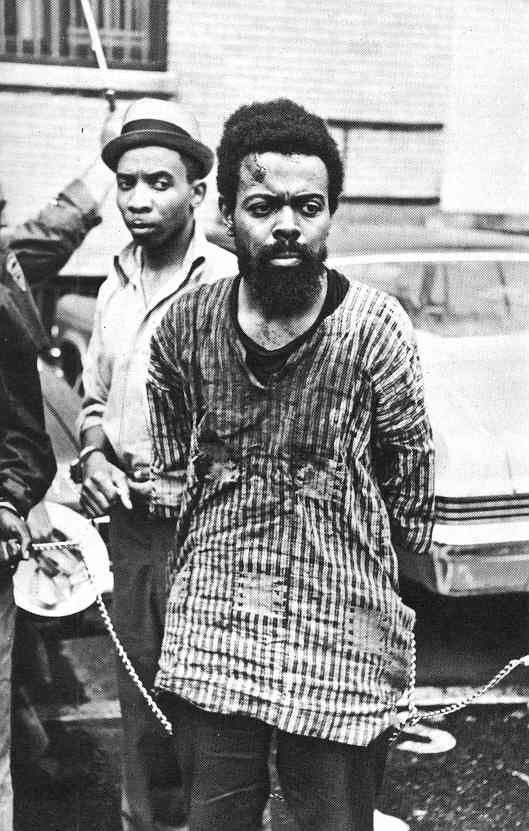
Playwright LeRoi Jones arrested
in Newark for possessing two loaded pistols – mid-July 1967
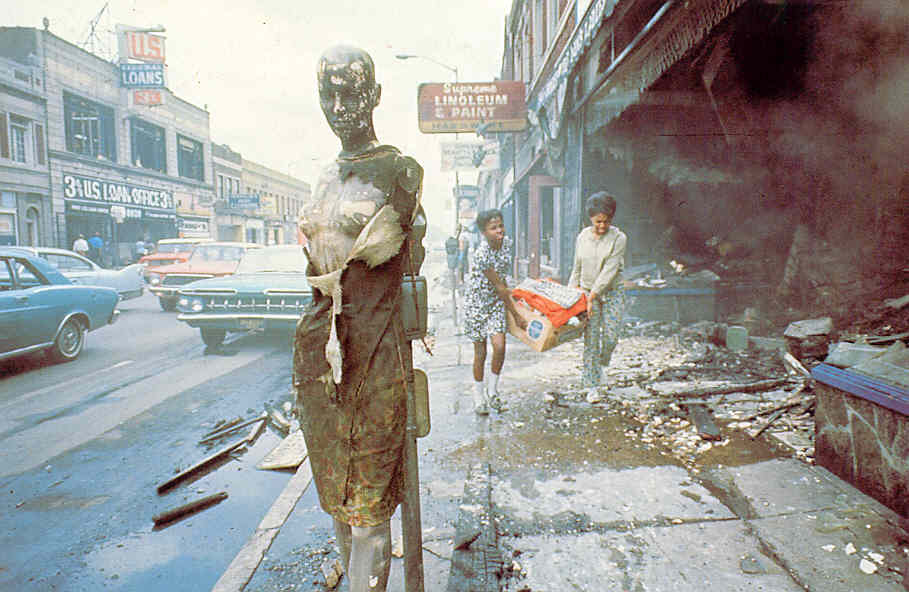
Detroit – 1967:
Black
summertime rioting and pillaging 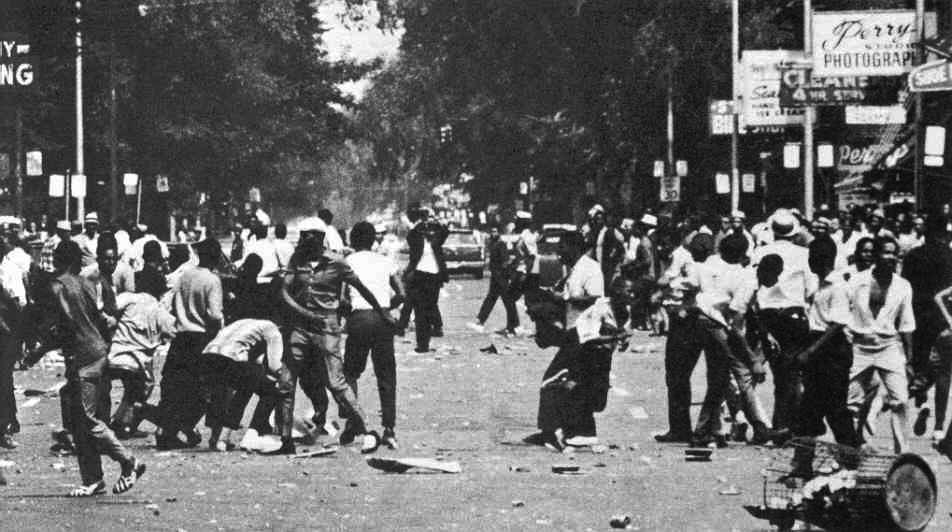
Blacks rioting in Detroit
– July 1967

Black district in Detroit
set afire – July1967.
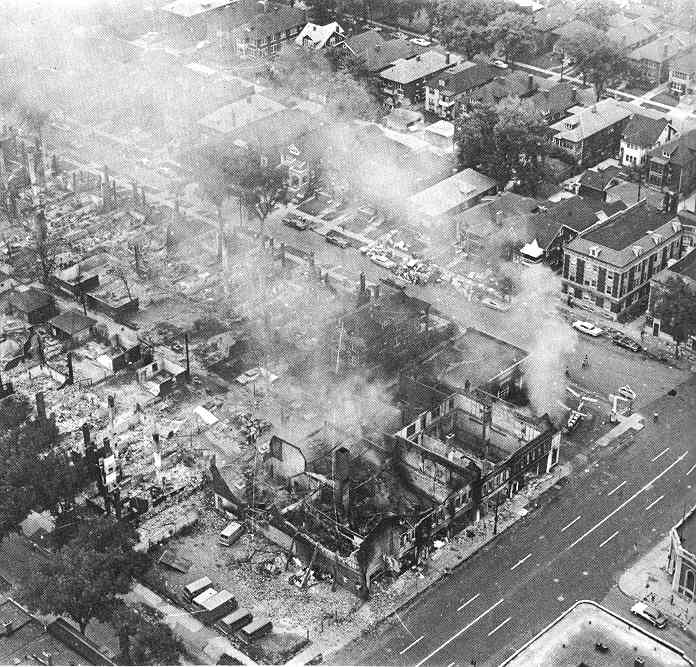
One of the many burned-out
sections of Detroit – late-July 1967
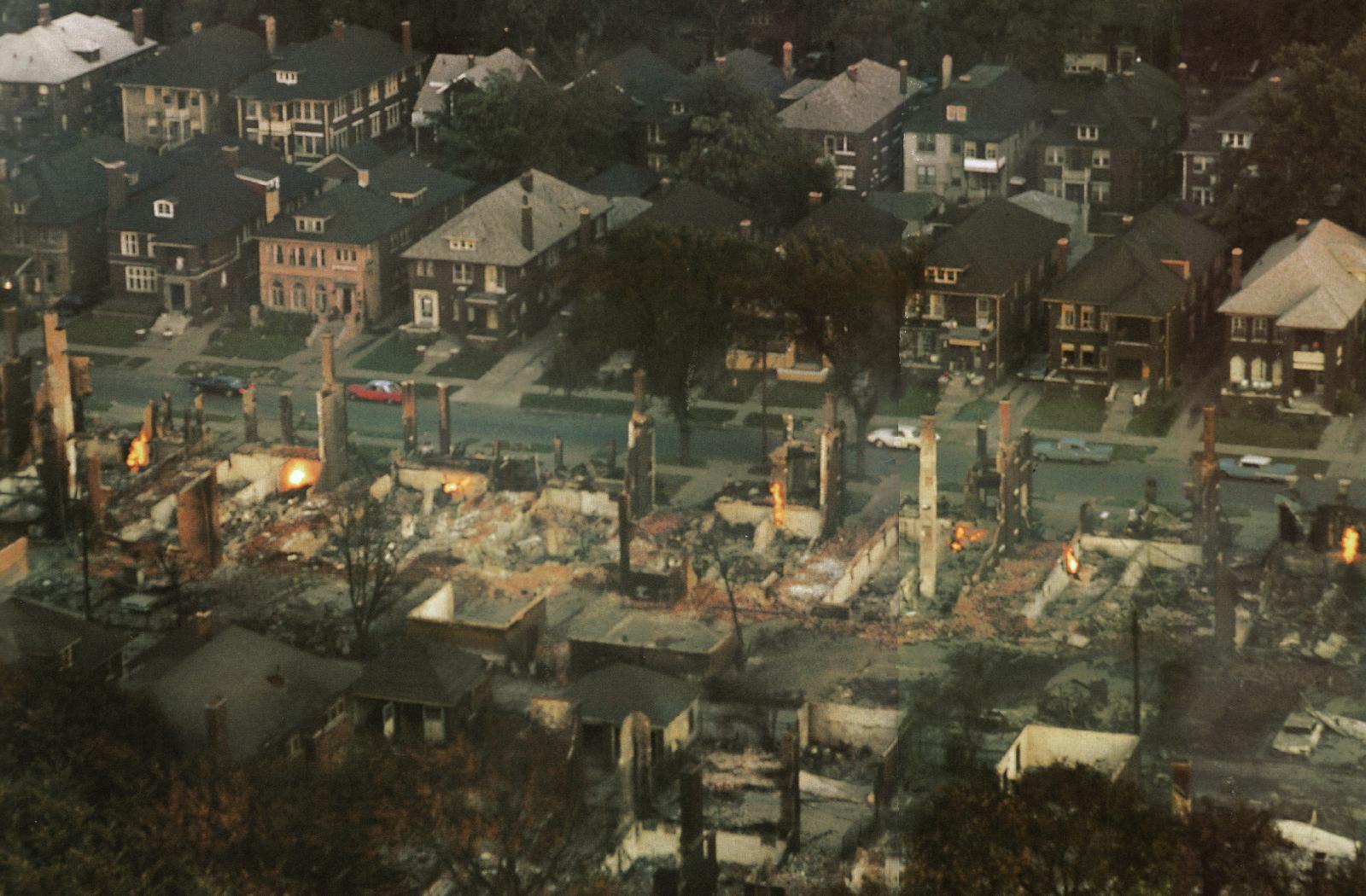
A burned out Black middle
class section of Detroit – 1967 (43 people died)
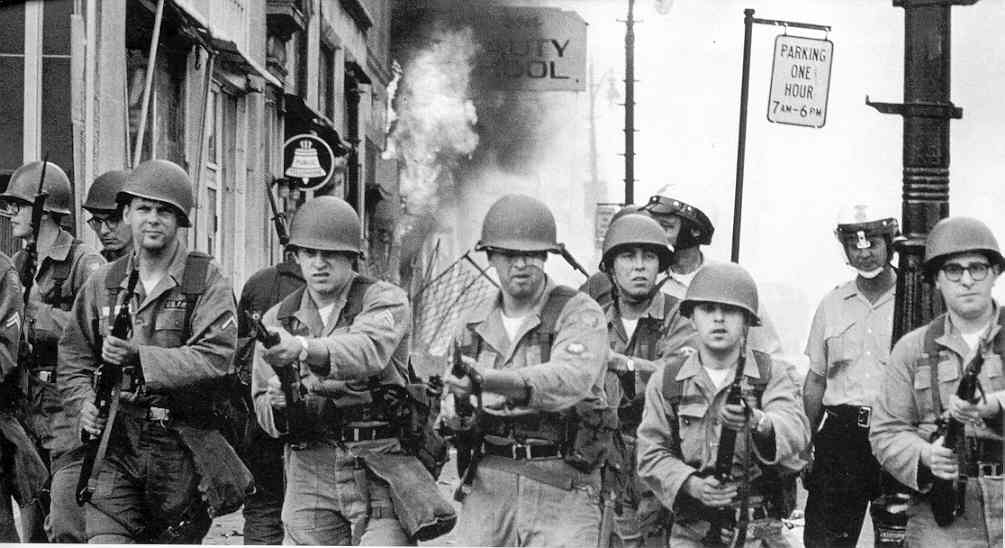
National Guardsmen in Detroit
– July 23, 1967
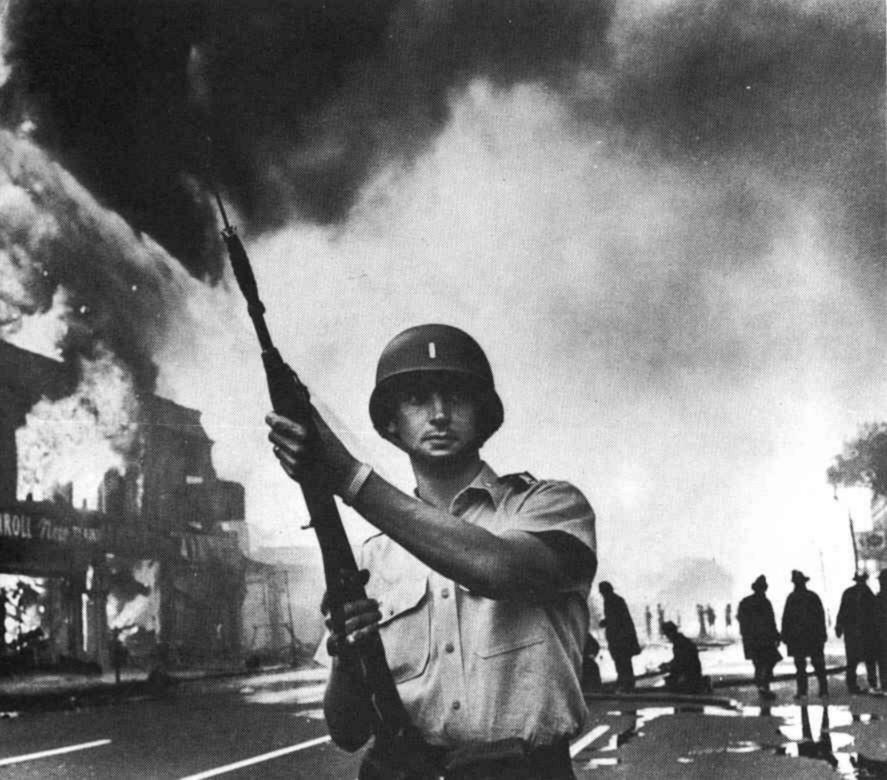
A National Guardsman standing
watch in Detroit as firemen battle blazes set by rioters – late-July
1967
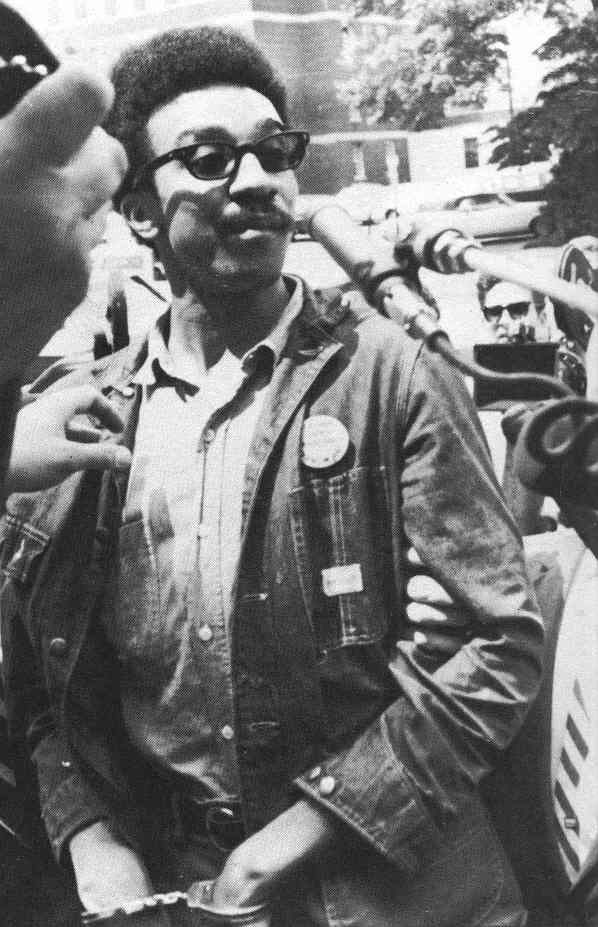
H. Rap Brown arrested for
inciting the Cambridge, MD riot – late July 1967
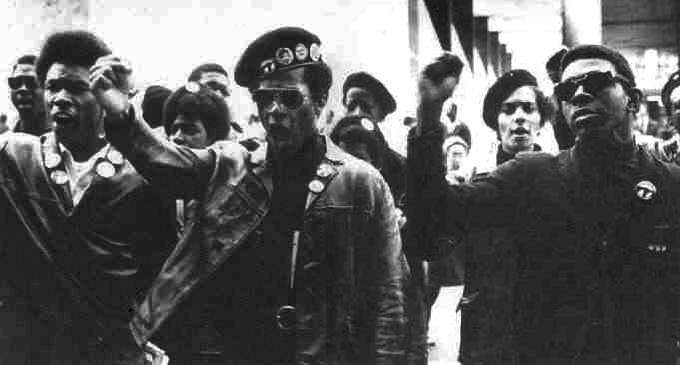 Black Panthers in a defiant
mood Black Panthers in a defiant
mood
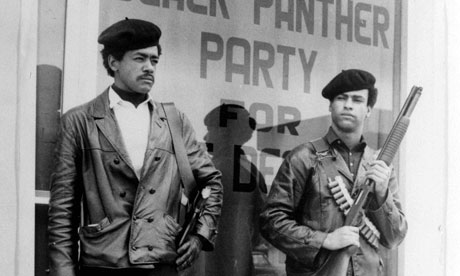 Bobby Seale and Huey Newton
Bobby Seale and Huey Newton
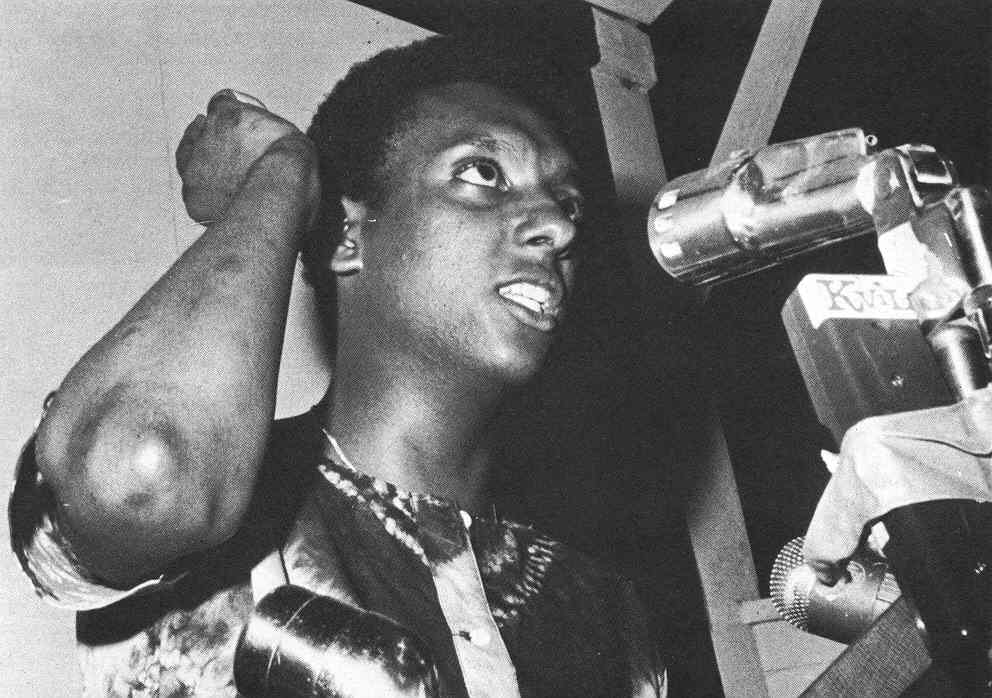
SNCC leader Stokely Carmichael
at a University of Texas gathering, denouncing US imperialism
A RISING CALL FOR AFFIRMATIVE ACTION FOR
WOMEN AND HISPANICS AS SUFFERING "MINORITIES" |
A new feminist movement stirs in America ... "Liberated" women claiming that they too suffer
from discrimination and want full equality with men in the professional world ... now.
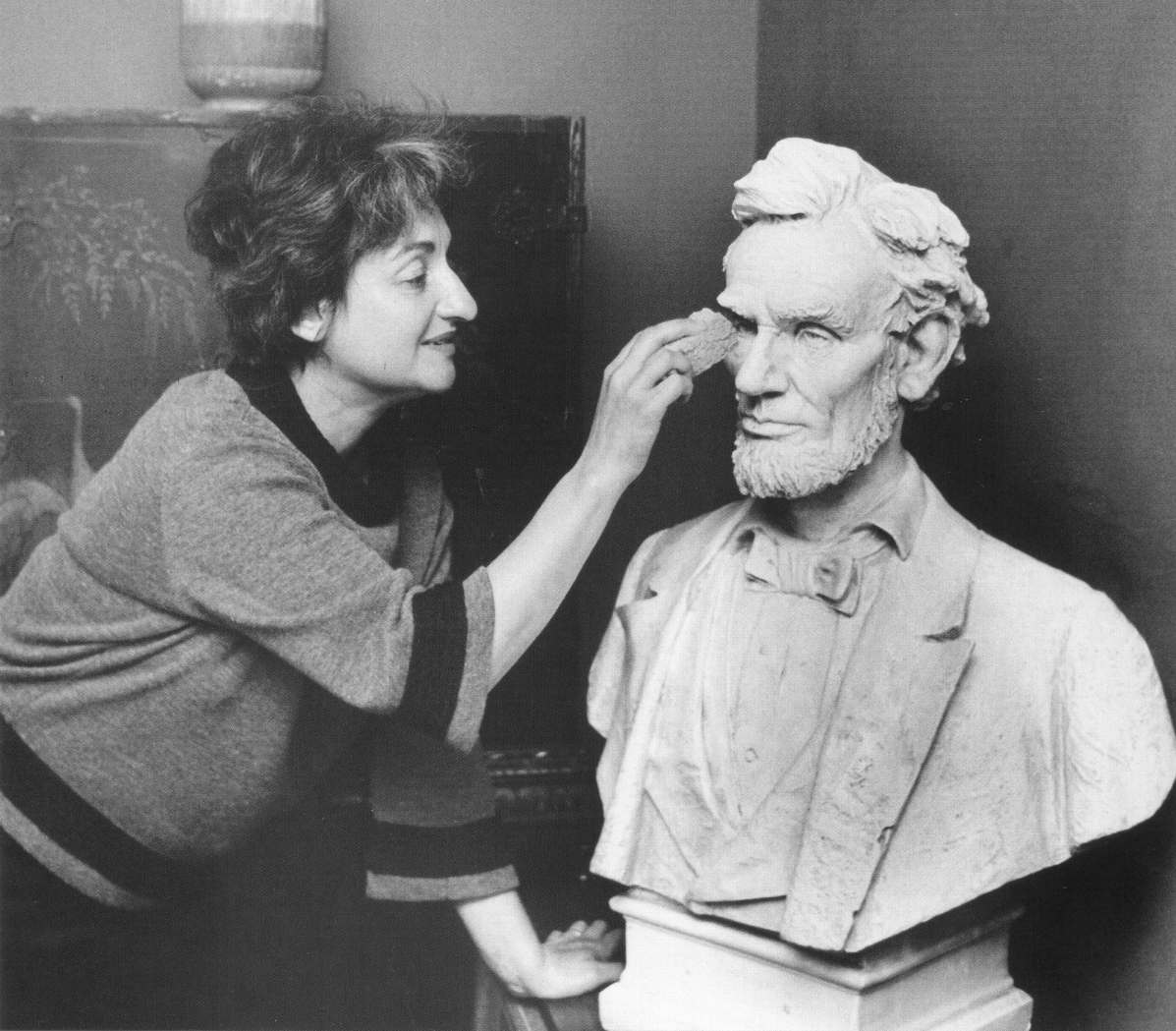
Betty Friedan, author of
The
Feminine Mystique, who attacked the 1950s idealization
of the American stay-at-home housewife and helped start the 1960s feminist
movement, demanding the opening up of the traditional male workplace to
women
Meanwhile, the civil rights
movement is building along another front: the call for a national
boycott of California grapes in
protest against the miserable working conditions of the Mexican migrant worker
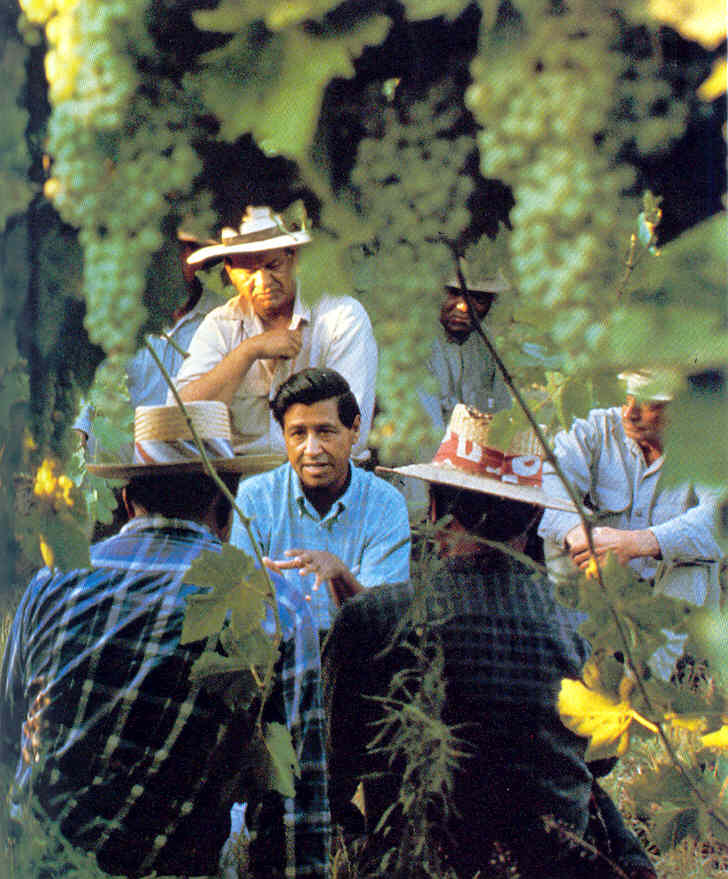
Cesar Chavez organizing grape
pickers in California – 1965
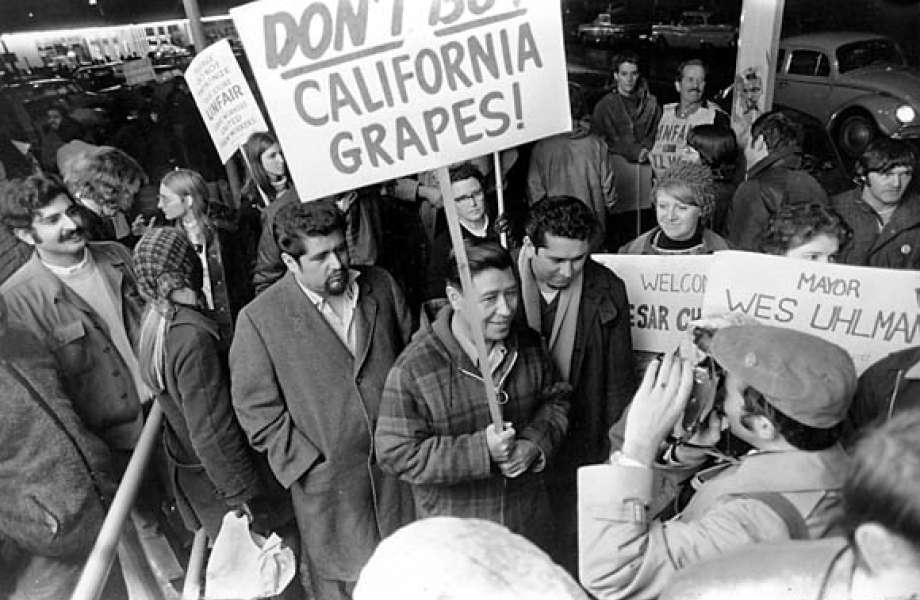
Chavez calling for a national boycott of California grapes – 1969
And just in general, Boomers find themselves crusading for most any cause – including a Free Speech Movement ... as if in America free speech is restricted?
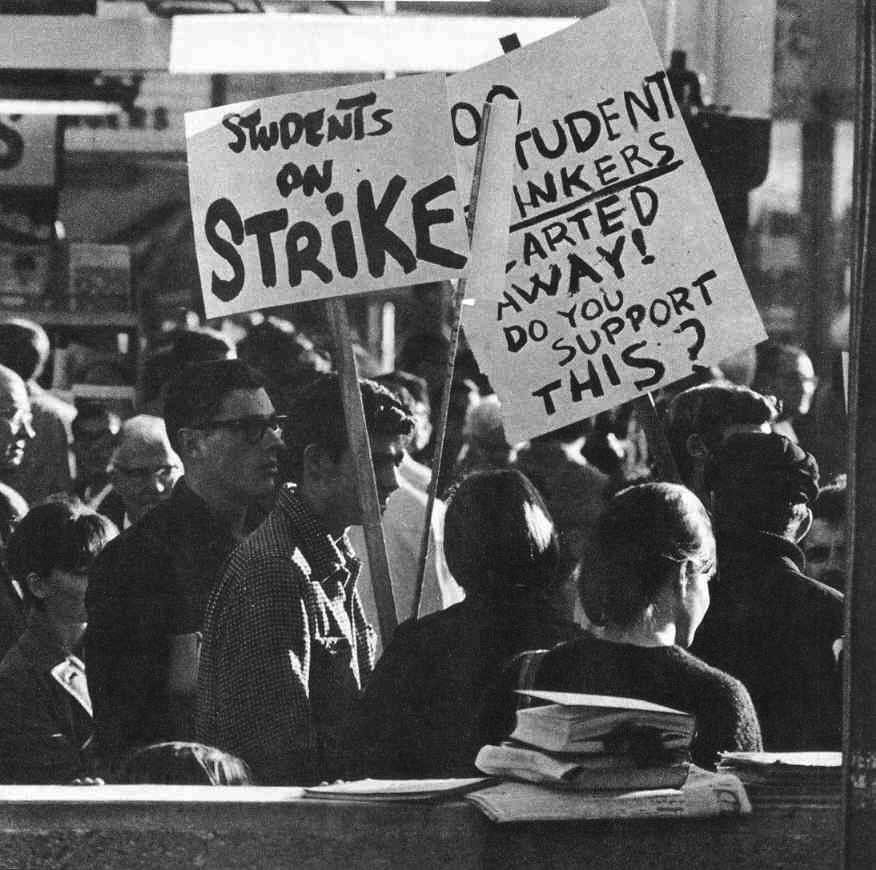
The startup of the Free Speech Movement – 1965
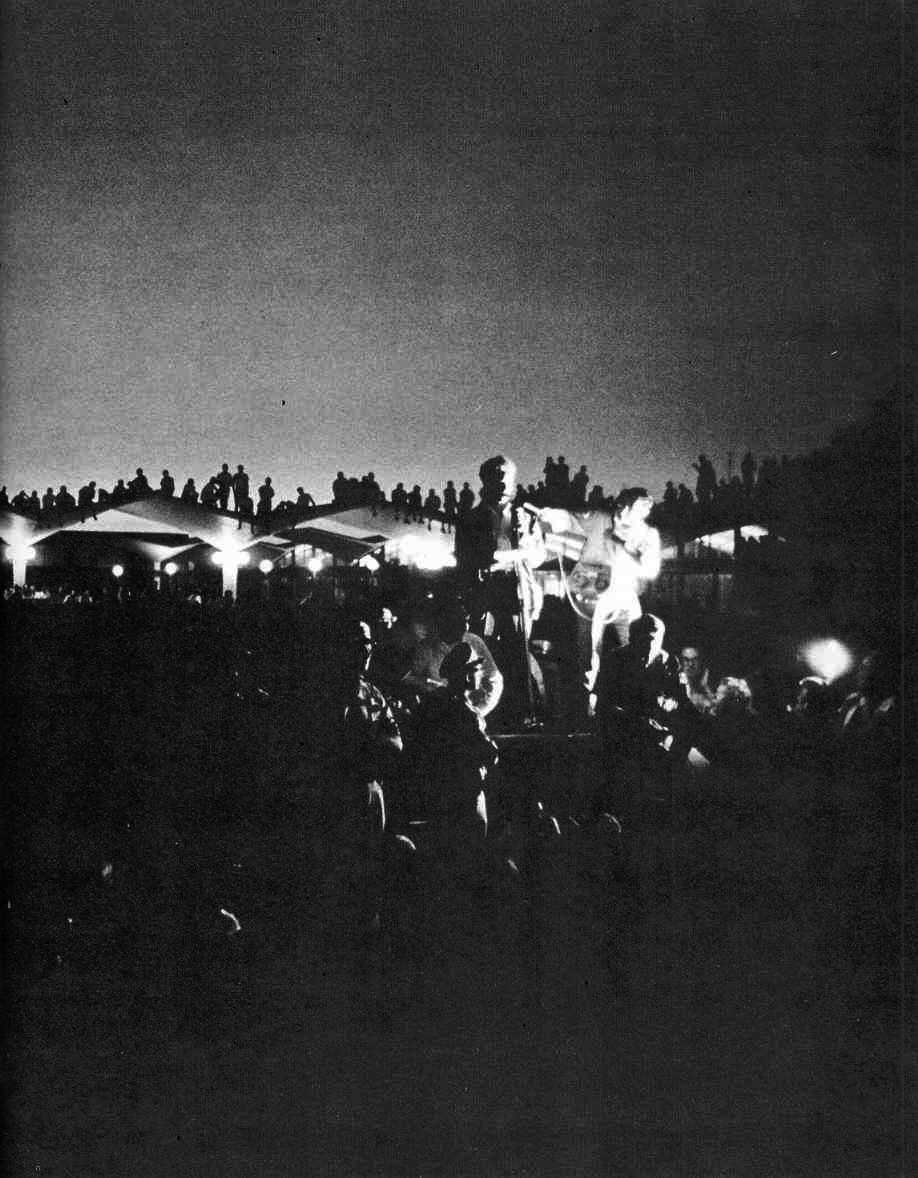
A Free Speech Movement nighttime vigil – 1965
THE GROWTH OF THE WASHINGTON WELFARE STATE ... AND THE RAPIDLY GROWING FEDERAL DEFICIT |
|
The growth of the Washington Welfare State
And thus it was that Black society began to
understand its rights as outlined by the Johnson Administration, and
thus to begin to demand not only assistance but also compensatory
action on the part of the national authorities. Blacks demanded their
rights be honored by those in power, not just rights to equal
opportunity in the pursuit of their personal destinies, as Dr. King had
expressed the dream, but rights to special advantages (affirmative
action) and compensations (public welfare) for past wrongs, in other
words preferential treatment or "entitlements." In this they would be
joining the Boomers in their understanding of the role of the American
government, and their sense of citizenship entitling them to be
receivers from, rather than contributors to, the strength of the nation.
Sadly this would lead only to a form of
social-cultural dependency on political favors and handouts, ones that
would block a robust personal growth arising from the self-help that
was historically typical of how Americans were supposed to work their
way to success. This kind of political dependency would slow rather
than speed up the advance of Blacks in American society economically
and socially.
But it did serve conveniently to give the
federal state in Washington all the justification it needed to expand
its social management programming "from above." And it created a whole
new category of professional "community developers" whose role was to
help redistribute or divert the nation's wealth in the direction of
their particular political constituencies.
It was the same game that urban bosses
had played with immigrants coming to their cities in the late 1800s and
early 1900s. "Support us in power and we will support you in the way
you live out your lives on a daily basis." But now it was a game being
played with America's "minorities" by the national bosses operating out
of their offices in Washington, essentially played for the same reason
that motivated the old urban bosses: to receive continuing political
support from their political wards (their minority clients) so as to be
able to stay in power, or better yet, so as to be able to expand their
power bases.
It was an old political game that shifted
locations simply in accordance with the fact of where American power
was to be found. As power shifted to Washington, so did all the old
political dynamics shift along with it. This was just crude power
dynamics at work, not the scientific social management that the
Behaviorists dreamed of.
The rapidly growing Federal Debt
Although this problem did not present
itself in as dramatic a form as other events of the times, nonetheless
a huge financial problem was brewing, one that threatened the health of
the government and the nation. By 1967 the amount of government
spending involved in both Johnson's Great Society and his heavy
military investment in Vietnam was outpacing enormously the
government's income from all of its tax sources. A huge deficit or
government debt began to build up as a result. In that year a
Commission on Budget Concepts studied the problem and concluded that a
proposed 1968 national budget was going to entail a (what was then
huge) deficit of anywhere from $2 to $8 billion in size.
Using the justification of
"rationalizing" the entire national or federal government budgeting
process, including the Social Security budget, which at that time was
largely self-running and not considered part of the national budget (or
"off budget"), the Commission recommended integrating the Social
Security budget with the regular operating budget of the federal
government. At that time the Social Security program, originally
focused on retirement or pension benefits of Americans but in 1965
adding also Medicare (health insurance for the elderly) and Medicaid
(health care for the poor, shared as a joint expense with the States),
was actually running a huge surplus, taking in each year in the form of
Social Security tax revenue more than it was spending for its various
programs. By combining the deficit-running federal budget with the
surplus-running Social Security budget, the government's budget deficit
built up by Johnson's programs could now be recast as being greatly
reduced, or possibly even be shown as running a surplus.
Thus in January 1968, Johnson introduced
the new unified budget. Yet even with the inclusion of the Social
Security surplus with the regular federal budget, Johnson was forced to
admit that the new unified budget would still be running up a $8
billion deficit (the government's expenditures were turning out to be
vastly greater than anticipated in 1967). But the figure was a lot
lower than it would have been without adding in the Social Security
surplus.
|
 Miles
H. Hodges Miles
H. Hodges
| | | | |


 The American presidency under
The American presidency under The making of Lyndon Baines Johnson
The making of Lyndon Baines Johnson The civil rights movement gains steam
The civil rights movement gains steam
 Johnson's "Great Society" program –
Johnson's "Great Society" program – American politics takes a left turn under
American politics takes a left turn under The continuing attempt to protect
The continuing attempt to protect Affirmative action also for women and
Affirmative action also for women and The growth of the Federal state ... and
The growth of the Federal state ... and











































 Black Panthers in a defiant
mood
Black Panthers in a defiant
mood








